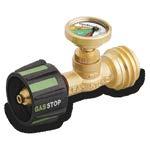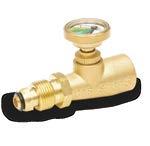




LEARN MORE...
WE STRIVE FOR NOTHING LESS THAN CUSTOMERS FOR LIFE.


ALWAYS MOVING FORWARD. ALWAYS MAKING YOUR EXPERIENCE BETTER.
Whether you’re on the road or on the water, Lippert supplies a broad array of premium RV, towing and marine products designed to enhance all of your recreational pursuits. Our team is always thinking about your next journey — pushing the possibilities of our products and services, all to better your time spent outdoors, whenever, wherever, for years to come.
lippert.com
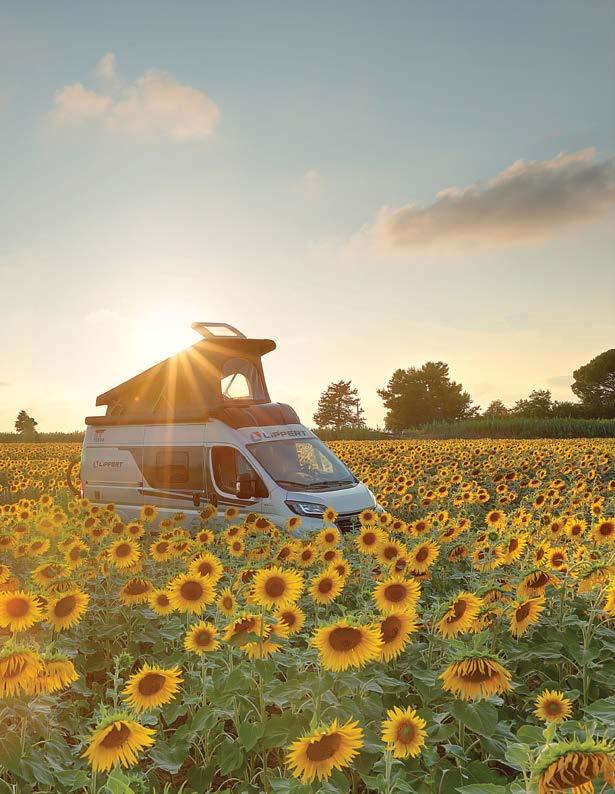


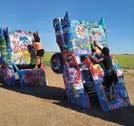








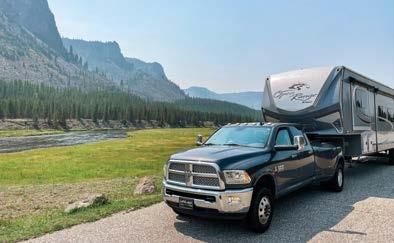
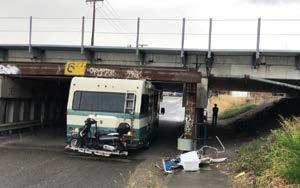
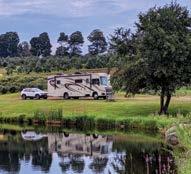




RV TODAY Magazine
Volume 1 I Issue 1 I February/March 2022
Publisher Demian Ross
Editor-in-Chief Nikki Kirk
Managing Editor Jess Stiles
Art Director Gayle Schadendorf
Operations Manager Jamie May
Copy Editor Kristin Skaggs
Social Managers Brandi & Jonny Peterson
Advertising Information sales@rvtoday.com

RV TODAY 3916 N POTSDAM AVE #3194, SIOUX FALLS, SD 57104
Disclaimer: One of the great things about digital publications is the ability to link you directly to the products or services you want to hear more about. Some of the links in this issue are affiliate links where we earn commissions on goods or services you buy. These commissions help us to continue to publish the magazine. Rootless Living is also a participant in the Amazon Services LLC Associates Program, an affiliate advertising program designed to provide a means for sites to earn advertising fees by advertising and linking to Amazon.com. If you have any questions please don’t hesitate to reach out to us at info@rvtoday com
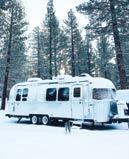
In November 2021, we released a special preview edition of RV Today, and that may be where you first heard about us. We couldn’t be more grateful for the response the magazine has had since we first announced. We have crushed all the goals we had for new subscribers, and the feedback we’ve received from readers has been amazing. Readers seem to be excited for a magazine that isn’t produced from inside the industry, but instead by people who are out there enjoying the lifestyle.
Part of RV life is disconnecting, and when you read a magazine on a device you can still find yourself needing power or getting easily distracted. This is why we are putting so much work into a truly beautiful print magazine. You can take it with you and enjoy some time reading about your passion for RVing and where to travel next without all the distractions.
The genesis of this endeavor is to create a magazine for RV owners, by RV owners—a place like no other where the contributors are actually out there every day, every weekend, or seasonally, sharing their stories, tips, and tricks to help other RV owners.
The goal is simply to help RVers get the most out of owning their RV—today.
You might not know we have another magazine called Rootless Living, which launched in January 2020. When I look back to that first issue of Rootless Living compared to its latest issue or even this first issue of RV Today, I can honestly say it’s gotten better and better, and I know RV Today will have the same growth. Every issue will get better and better and continue to be full of information to help our fellow RV owners.
But none of this will be possible without you! We would love to hear from you, including suggestions for stories or regular features, plus ideas for what kind of content would help you and other RV owners in the future.
Email us at collab@rvtoday.com to help us make your magazine even better
demian@rvtoday.com


@wander.onwheels


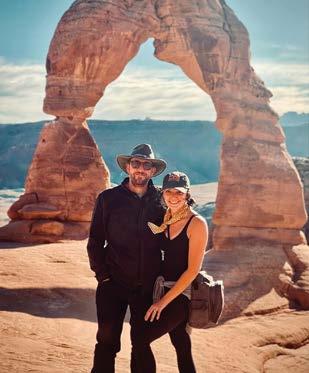
ʹFreedom, intentionality, a stronger marriage, space to be our truest selves, and much more!ʹ
@lifessweetjourney
ʹExperiences, people, and to never stop learning!ʹ
@fullstreamaheadtravel



ʹTo break old habits and create new memories!ʹ

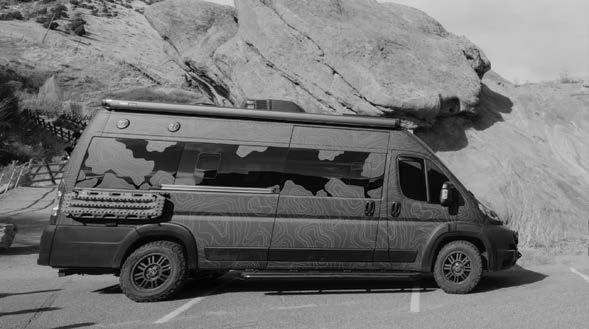

Aaron Tucker and his loyal companion have an impressive background in tactical training, obstacle course racing and so much more. Aaron is a retired firefighter paramedic, cadaver K9 handler, tactical medic and a police officer with two decades of experience. His extensive knowledge led him to build the K9 care standards when working for the Florida SWAT Association, giving these furry heroes better conditions to thrive. However, more recently as a retired vet, Aaron and Archer have traveled the country in their Jayco Swift to raise awareness for mental health and compete in vigorous obstacle course races where he showcases the importance of service dogs.


 By Stacey Maxon
By Stacey Maxon
Whether it’s your first trip or your 101st, planning an RV trip can be overwhelming. You have to consider the route, multiple stops, activities, and campgrounds—it’s no wonder that most people don’t use their RV as much as they would like to. If you’ve been dragging your feet, here’s your nudge to stop procrastinating and start planning. The following are eight recommendations for planning your 2022 RV trips.


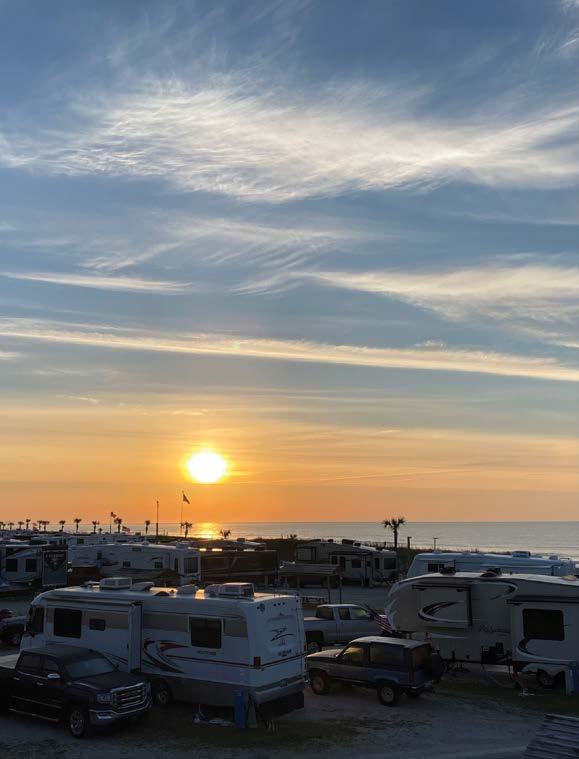
1 DO PLAN AHEAD Most campgrounds allow reservations up to 12 months in advance, with state and county campgrounds allowing bookings 6–9 months ahead. If you want to get the best sites at the best campgrounds, it’s important to plan ahead and make reservations as soon as the booking window opens.
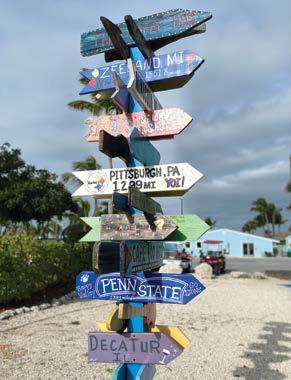
2 DO USE AN RV-SPECIFIC GPS It may not be something you’ve considered if you’re new to RVing, but due to the size and weight of your motorhome, travel trailer, or fifth wheel, there may be some roads, tunnels, or overpasses you’ll need to avoid. It’s important to be aware of the height of your unit so you can travel safely. There are RV-specific apps and truck apps that will plan routes taking into account the height and weight of your vehicle so you can avoid roads your vehicle will not fit on safely.
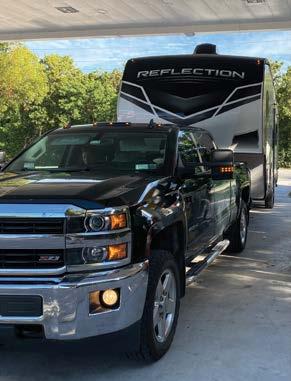
3 DO BE CAUTIOUS AT GAS STATIONS Gas stations are the number one place that RV owners get into trouble. Minor accidents can occur when maneuvering around the pumps and tight parking lots. Try to use truck stops, such as Love’s or Pilot, where you will have more room to access pumps. If one is not available, make sure the gas station you choose does not have limited height requirements and that it has more than one entrance/exit so you don’t have to worry about turning or backing up.
4 DO HAVE A BACKUP PLAN There will be times when weather or other events beyond your control take you away from your chosen path or plan. Be flexible and have a backup plan. Do you have friends or family in the area that you can stay with or is there a route you can take to safety? Remain alert to the weather so you don’t get stuck in a dangerous situation.
5 DON’T GET STUCK WITHOUT A PLACE TO STAY
If you are having trouble finding a site when you are en route, consider alternative camping sites. There are companies like Harvest Hosts that allow you to boondock overnight at participating wineries, golf courses, and amusement parks, while Hipcamp advertises properties that are owned by individuals. You can also choose to boondock in certain parking lots overnight.

6 DON’T PLAN ON TRAVELING MORE THAN 400 MILES IN A DAY Driving an RV is not like operating a car. I remember taking road trips where we would drive 1,000 miles, only stopping at rest stops to use the bathroom and take a quick nap. It is not safe to do that while driving an RV or towing a fifth wheel or travel trailer. Driver fatigue happens more quickly when operating such a large motor vehicle, so it’s important to take frequent breaks. We recommend traveling no more than 400 miles per day because it allows you to limit travel to daylight hours.
7 DON’T SKIP A PRE-TRIP INSPECTION Prior to hitting the road, it’s important to thoroughly inspect your RV so you can find any existing problems. Be sure to thoroughly check brakes, tires, and electrical systems so you can prevent any mishaps while you are traveling.
8 DON’T FORGET TO PLAN SECONDARY DESTINATIONS Often when planning a trip, you focus on a main destination, but with RVing it is also important to plan out secondary destinations. This goes along with not traveling too many miles in one day—since you won’t be rushing to your main destination, you can plan to see many attractions along the way. This will make it much more enjoyable.
So those are the eight do’s and don’ts of planning your next RV trip. If you are still overwhelmed with planning, try starting out with shorter local trips where you don’t have to worry about several stops. You can also purchase a pre-planned itinerary or hire an RV planner to work with if you’re going a longer distance or traveling to an area you are unfamiliar with. ■
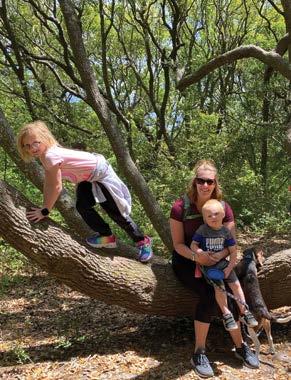
FIt’s no secret that RVs don’t get great gas mileage. Whether you’re driving a motorhome, towing a fifth wheel, or even traveling in a van, many full-time travelers suffer at the gas pump. The solution for many is to drive slower or stay in one spot for longer. Or, they simply have a big line item in the budget for gas! No matter what, one thing is for sure—we all like to know what gas mileage everyone else gets!






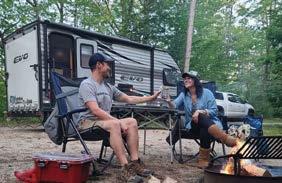

Just when you think you’ve seen it all, a mindboggling apparition appears on your horizon. For me, it was Cadillac Ranch, sitting in the middle of a flat, lonely cow field in northwestern Texas. There are many whimsical, funky roadside attractions along Route 66, but Cadillac Ranch is definitely a favorite. My internet research found conflicting information about Cadillac Ranch’s origins. Some sources give credit to three artists from a hippie architectural
practice in California called The Ant Farm—Chip Lord, Doug Michels, and Hudson Marquez. These informers report the artists designed the project and approached eccentric Texas artist, businessman, and philanthropist, Stanley Marsh 3 (1938–2014) for financing. Other sources credit Marsh as the mastermind of the idea and indicate he contacted the hippies to erect this tribute to his favorite classic car—the Cadillac.




About the Author
Gerri Almand found her voice in humorous travel writing when her husband insisted they buy an RV and travel the country. The Reluctant RV Wife, Home Is Where the RV Is, and Running from COVID in our RV Cocoon chronicle her transformation from initial RV reluctance to an ecstatic embrace of full-time nomadism. Learn more at gerrialmand.com.

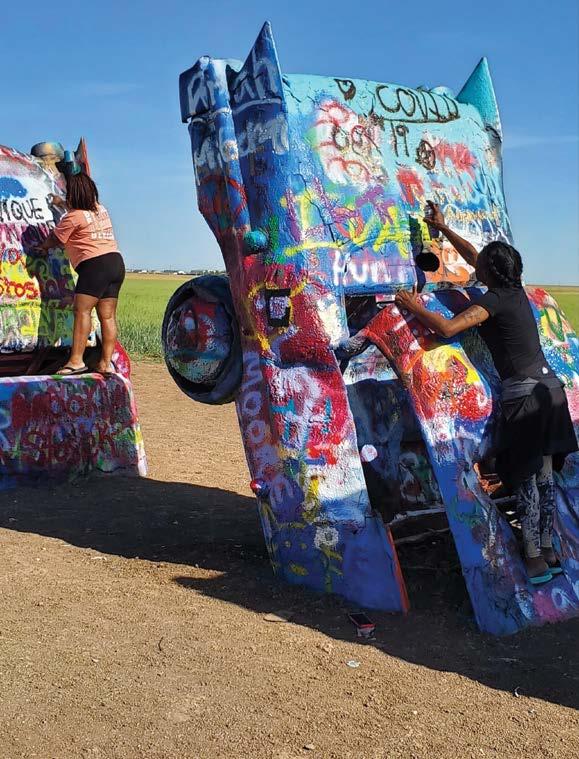
Intended as an homage to the Cadillac’s tail fins, the Ant Farm artists collected ten junked-out cars built between 1949 and 1963 and buried them in chronological order, nose down, in a field along the original Route 66. They completed the project in 1974. In 1997, as construction of Interstate 40 destroyed parts of Route 66 and often deviated from the original highway, Marsh ordered the cars relocated to its current site about two miles south of I-40 and five miles west of Amarillo.
The site became a mecca, and travelers from all over the world now come to regard the bizarre display that has tickled so many chakras. Over time, visitors stole every removable part to take home as souvenirs, including the revered tail fins. By the time my husband and I first saw the exhibit, only battered, stripped-down Cadillac shells remained, and these husks changed daily as visitors swarmed with cans of spray paint to leave their marks.
We first visited Cadillac Ranch in November 2016. After parking along a narrow road, we joined the line of folks waiting to enter the pasture. The atmosphere felt party-like. As we passed through the open gate, we noted the subtle humor of a No Trespassing sign and a padlock on the fence … not on the gate.

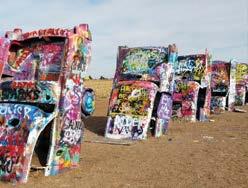
Despite howling winds and temperatures in the low fifties, we lingered in that desolate site for more than an hour. It seemed like everyone did. We walked around and between cars, studied details, and tried to decipher scrawled names and messages. Not even the noxious paint fumes made us rush. The experience felt sacred—almost religious.
Over time, the cars have been periodically repainted. Once, Marsh had them painted white for a television commercial. Another time, they were painted pink in honor of his wife’s birthday. When one of The Ant Farm artists died, the cars ended up flat black to express mourning. In 2012, painters covered the cars in rainbow colors to celebrate
Pride. At one point, as part of a Route 66 restoration project, the Hampton Inn motel chain restored the Cadillacs to their original colors. In 2020, activists painted the cars solid black, with the words “Black Lives Matter,” to protest police brutality and George Floyd’s murder. With every change, the new colors last only a few hours before visitors arrive with paint. Cadillac Ranch is a living, interactive art form, constantly reinvented by visitors who leave a different shrine than the one they found.
During our first viewing, we didn’t know we could leave graffiti. We wanted to return, and considered doing so as we passed through Amarillo in 2019. However, recent rains and reports that we’d sink ankle-deep in muck kept us away. We saw Cadillac Ranch again in 2020 during sweltering ninetydegree temperatures in late May. Although we knew to bring paint this time, we didn’t bother. As we expected, a couple of visitors handed us spray paint cans on their way out, and we dutifully left our marks. It felt right to have successfully completed the pilgrimage.
The Cadillacs have now been buried in the ground longer than they were on the road. I want to believe they’ll be there forever, inspiring visitors to consider alternative ways of viewing art and perhaps even shaking loose creativity in the minds of the beholders. But if not, I’m comforted to think they’ll perhaps trigger the imaginations of us lucky ones who have seen them.
Not only did Stanley Marsh 3 face sexual assault allegations before his death in 2014, but many people also viewed his artworks as eyesores with little to no artistic value. Marsh’s response to the critique? “Art is a legalized form of insanity, and I do it very well.” He reportedly loved those nose-buried Cadillacs, feeling the graffiti gave them a patina, like Chinese vases that increase in value with every new crack.
If you visit Cadillac Ranch, you’ll see a different roadside attraction than the ones I saw. Yours will have a shinier patina, I’m sure. ■
 By Anne Klumpp
By Anne Klumpp
In my previous life, before I became a nomad, I earned a living by selling wine. Over my 25-year career, I had incredible opportunities to visit wineries in California, France, Italy, Spain, Portugal, Chile, Argentina, and South Africa. These adventures fueled my passion for travel and primed me for rootless living.
While I left my job behind, I didn’t abandon my love for food and wine. In fact, my husband, Brian, and I explore local culture through food and beverage whenever we get a chance. This year, we thought we’d bring our travels and our passion for wine together by exploring some of our country’s best wine-producing areas, including four weeks in the northern Willamette Valley, the heart of Oregon’s wine country.
WHETHER YOU’RE VISITING OREGON’S WINE COUNTRY OR ANOTHER GROWING REGION, THESE GUIDELINES WILL HELP YOU WITH YOUR SCHEDULE:
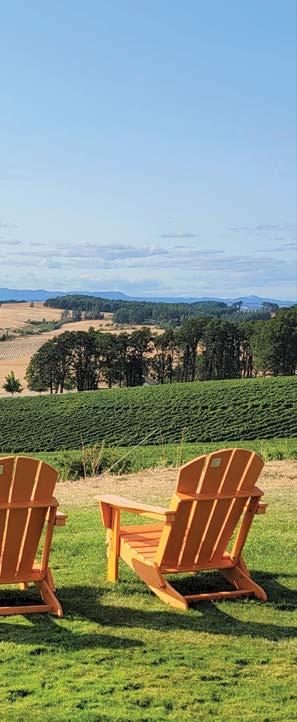
☑ Plan 90-plus minutes for each tasting. Ninety minutes gives you time to get a seat and purchase any wines you want before leaving without rushing the tasting.
☑ Consider the travel time between wineries. If they are all in one central area of the Valley, you could probably see four wineries in a day, but why push it? We prefer a morning appointment and one or two afternoon appointments, with lunch in between.

☑ Investigate what wines they produce before booking the appointment. For instance, you may not want to visit a winery that only makes red wine if you prefer white wines.
☑ Think about your goals. If you want to restock your wine rack and your budget per bottle is $20, you probably don’t want to visit wineries where the least expensive option is $50. On the other hand, if you’re trying to understand why
some wines cost so much, investing in the price of a tasting flight at a higher-end winery is less expensive than buying multiple bottles from them to conduct a tasting of your own.
☑ Take note—with the small size of some wineries and COVID restrictions, many wineries recommend or even require reservations.


☑ Don’t wear fragrances, including perfume, aftershave, and scented hand lotion. Trust me! Everyone is there to smell what’s in the glass, not what’s on your skin.
☑ Eat something before you go. Even if you spit or only take tiny sips, your tongue absorbs some alcohol. Having something in your stomach before you begin tasting will prevent you from getting sloppy or sick.
☑ Designate a driver. There are also guides you can hire who will set up your day and escort you and your group from winery to winery. Keep in mind these guides don’t always pick you up at home, so make sure you can get yourself safely back home from the pickup/dropoff point.
☑ Wait to taste until the person pouring finishes their presentation. They may suggest how to taste or prefer you hear a portion of the story first.
☑ Ask questions. There are no stupid questions! If you have a question, someone else is probably wondering the same thing.
☑ Split the pour into more than one sip. The first taste is often a surprise. After your palate has had a chance to adjust to what it’s currently tasting, the second sip is a better time to judge the wine.
☑ Give feedback about your preferences politely— avoid words like hate, gross, bad, etc.
☑ Express gratitude. Support the business through purchases, and thank your host for their time, answering your questions, or having a good sense of humor.

☑ The tastings we attended in Oregon ranged between $10 and $50 per flight. Many tasting rooms will comp the tasting if you purchase a bottle or sign up for their wine club.

☑ Flights generally consist of four to six wines. Depending on the questions you ask, the feedback you give your server about your preferences, and what the winery may be trying
to promote, the server may pour additional wine for you.
☑ An average pour is one ounce, but some wineries are very generous. Keep in mind that there are just over 25 ounces in a bottle. Counting the number of wines you taste will help you track how much wine you are consuming.
5
☑ See—Notice the wine’s appearance. Is it light or deep in color? Transparent or opaque? How quickly does the wine move about the glass? Does it appear thick or thin?
EXPLORE SOME OF OUR COUNTRY’S BEST WINE-PRODUCING AREAS, INCLUDING THE NORTHERN WILLAMETTE VALLEY, THE HEART OF OREGON’S WINE COUNTRY.
☑ Swirl—I’ve always found it easiest to keep the wine on the table for this. With your fingers at the base of the glass’s stem, draw small counterclockwise circles. This action exposes the wine to air, which releases the aromas of the wine.
☑ Smell—Close your eyes, stick your nose in the glass, and imagine you’re standing in the produce section of the market. What fruits do you smell? What things other than fruit do you smell?
☑ Sip—Taste the wine, moving it around in your mouth before you swallow. Skilled wine tasters slurp in a bit of air while sipping. Like swirling the wine in the glass, this releases aromas as the wine enters your mouth.
☑ Savor—Take a moment to decide how the wine was for you. Do you like it? Unsure but want another sip? What would you enjoy eating while drinking a glass of this wine? Do you want to buy it?
Most of the wineries we visited made our list because of their reputation and our past personal experience with their wines. As it was our first time in the Willamette Valley, we explored many areas. We divided the locations into separate days, which worked out very well for us.
HERE’S HOW WE SPLIT UP OUR DAYS:
Day 1: Eola-Amity and Van Duzer Corridor (north of Salem)—Illahe Vineyards & Winery, Bethel Heights Vineyard, Van Duzer Vineyards

Day 2: Dundee Hills/Ribbon Ridge—Argyle Winery, Patricia Green Cellars, Adelsheim Vineyard
Day 3: Yamhill/Carlton—Saké One, Anne Amie Vineyards, Elk Cove Vineyards
Day 4: Eola-Amity (south of Salem)—Willamette Valley Vineyards, St Innocent Winery
The Willamette Valley offers lots of other things to do beyond wine tasting, with plenty of hiking, biking, and waterways to explore. And since it’s only about an hour to Portland or Oregon’s coast, it’s a central location for exploring beyond Oregon’s fabulous wine country. ■


Anne Klumpp, her husband, Brian, and their dog, Skipper, have been traveling full time in their Class A motorhome since April 2019. They share their adventures, including their experiences of local culture through food and beverage, home cooking, and RV travels on Instagram @ontheroadofadventure and Facebook. Or visit their blog: ontheroadofadventure.com.

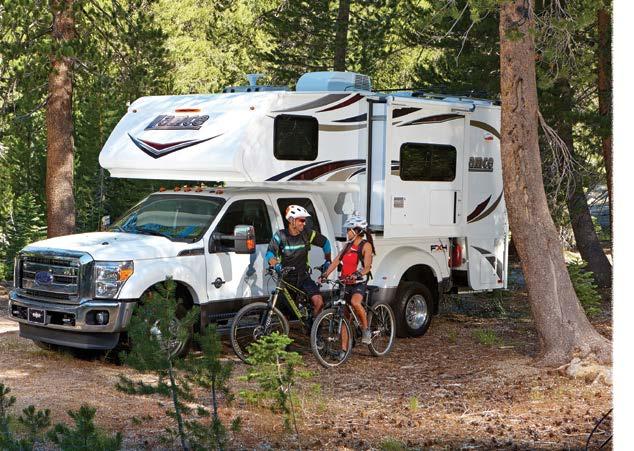




Don’t be impulsive. Even though you might want to hit the road as soon as possible, buying an RV too quickly can almost guarantee disaster down the road. This is a purchase worth taking your time on
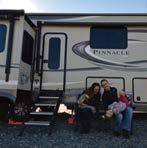
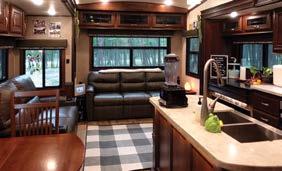 By Jess Stiles
By Jess Stiles
Make a list of features that you truly need versus items that are nice-tohave. It also helps to list items that you don’t need at all and compare these three lists to the RVs that you’re looking at
 – Christine Skelton @_neverstopadventuring
– Christine Skelton @_neverstopadventuring
Research floor plans. You may not know anything about RV brands when you get started, and that’s actually great! Instead of being biased toward brands that are great with marketing, you’ll be looking at an RV for how it fits your lifestyle
Find out known issues for brands.
As you narrow your search, it’s really important to look into each RV brand and model to see what known issues are associated with it. This information is readily available online.

When we were first searching for an RV, I was thinking about our lifestyle in a sticks and bricks home and how much stuff we needed to bring with us. In reality, RVing is more about the places, people, and experiences than the things you have with you. Sizing down also means better gas mileage, which means more places you can go!
 – Kyli Robertson @kyli.brook
– Kyli Robertson @kyli.brook
Decide how big is big enough. Most people need a lot less space than they think—a lot of RV owners end up downsizing their rig after a few seasons. It just takes time to figure out what you need and your travel style.

Where do you want to camp? Answering this question can help you decide how big of an RV you need. If you want to find remote places off the grid, you will want a smaller rig for narrow roads and maneuverability. If you’re happy to pull into a campground and hook up, then size isn’t as much of an issue and you can comfortably go bigger.
Are you getting away, or are you going to be working from your rig? Is your plan to adventure, being in a new place almost every day, or are you the type who would rather set up in one spot and spend some extended time there?
All these things should influence your choice of RV size, layout, and features.
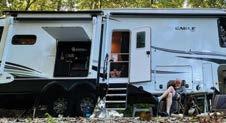
 – Paula Eve @eve.n.paths
– Paula Eve @eve.n.paths

How many people are you traveling with?

This is another great consideration to help determine how large of an RV you need. Although bigger is not necessarily always better, bigger families will of course need more space. And Mom and Dad will probably appreciate having their own bedroom when taking the whole family out for a camping trip!
Motorhome vs. tow. This is usually an easy decision to make if you don’t want to tow anything. For those on the fence, be sure to tour both kinds of rigs to determine the best fit for your travel style.
Before owning an RV I had never driven a vehicle larger than a small moving van, and certainly had never towed anything! We took a gamble on our fifth wheel, which thankfully has done well for us, but renting before buying would have taught us that something smaller with no slides would work better for our travel style.
How much do you want to drive?
Consider how many miles you’ll be traveling in your RV while shopping. If you want to do long cross-country drives, you may want something newer with manufacturer warranties, whereas that may not be as important if you’ll be staying near your home base and dealership.
Attend an RV show. There are several RV shows across the country throughout the year. Search online for the next RV show near you and go there to tour different brands. Many RV manufacturers bring RVs to the show with the intention of selling, so you may also get a great deal if you’re in a position to buy.


Rent an RV first! This is a great way to test out the size and style of an RV before you buy. You can get a feel for how to drive and operate the vehicle before investing many thousands of dollars into your own.
Where are you going to keep it? If you’re not allowed to keep your RV at your house due to an HOA or covenant, have you considered RV storage and parking? Be sure to factor in the secondary cost of RV storage if needed.
– Kyli Robertson @kyli.brook
Know your budget. If you’ve done adequate research, you should feel good about what you want for your family. The next big question is how much do you want to spend? Keep in mind that just because you can spend a certain amount, doesn’t mean you have to. There are deals to be had—keep reading for more.
Are you financing? Knowing how much you want to pay in cash as opposed to financing will help you narrow down your options while shopping for an RV. Not all RVs or trailers are financeable, and your credit score will determine how much you can borrow.
Get the right loan. If you’re financing your RV purchase, look into loan options and consider a personal loan. Loans offered through RV dealerships sometimes have terrible terms that end up costing RV owners far more in the long run.
Buying new or used? It’s no secret that RVs lose up to 30% of their value as soon as you drive them off the lot, which is a tempting argument for buying used. However, be sure to consider the added costs of repairs and updates that may be required for a used RV. New RVs cost more, but they usually come with manufacturer warranties and dealership maintenance programs.
Buy at the end of the year. As with many things, timing is everything when buying an RV. Many RV lots mark down inventory at the end of the year to make room for next year’s models. In addition, shopping at the end of the month can be advantageous if dealerships are looking to make a sale before the month closes.

Sit on the toilet and shut the door. Stand in the shower and raise both arms. Stand in front of the mirror and pretend to blow dry your hair. It’s hard to tell if you’ll be comfortable in your RV bathroom until you really get the full experience!

 – Jen and Sovann Sy @RetireeWannabes
– Jen and Sovann Sy @RetireeWannabes
Bathrooms—How many do you want and how large do you want them to be? Do you need a tub to bathe kiddos, or are you rolling solo and just need a wet bath with standing room only? A large, featurerich bathroom may not be important to you if you’re planning to spend most of your time in campgrounds that have washroom facilities.
When deciding on a fifth wheel, we knew our kids would need their own space as much as we needed ours! Having the mid-bunk room in our Grand Design Reflection gives us the perfect layout, with lots of living space and the two bedrooms we needed for harmonious RV living!
 – Betsy Burns @eatglamplove
– Betsy Burns @eatglamplove
Bedrooms—Think about whether you need a single room with a queen bed or multiple rooms with plenty of space for bunk beds. There are so many different layouts for RVs that you’re bound to find one that will work for you!

Kitchen appliances—Are you determined to have a large fridge, a farmhouse sink, and a dishwasher in your RV? If so, you’re looking at a much different RV than one with a cooktop and sink combo unit.

Test everything out. Sit on the toilet, pretend to take a shower, lay in the bed, and imagine cooking a meal in the kitchen to get an idea of how your life would look and feel in the RV.
Outdoor kitchen—Cooking outdoors is, without a doubt, easier than cooking inside. Luckily, RV manufacturers are making built-in outdoor kitchens more common in their designs.
Expandable Solar

System tiers for all budgets
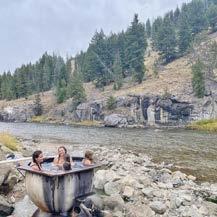

Custom fabrication for desired system intergration
LIFESTYLE. POWER. BUDGET. SOLUTION.

When we see a problem, we don’t just find a solution; we help make changes in the industry you’ve been waiting on that make your journey easier every single day. The products our team uses are the most innovative products on the market and we take the time to learn them inside and out so you don’t have to. With over 35 years of industry expertise, our team can design, fabricate, and install the Solar and Lithium system that’s fits your rig perfectly to make your battery life bigger.


Many people travel with a pet and will love some of the pet-specific items RV manufacturers are including in their designs. From kitchen drawers that hold food and water bowls to built-in kennels, you’ll want to look for these features if you need them for your furry friends.
Washer and dryer—So many amenities can be found in RVs these days, including washers and dryers! While many RVers find it easier to do laundry in a laundromat or at a campground, you may prefer to do laundry in the comfort of your own RV. Consider this factor while shopping for your rig.
We debated between the combo washer/dryer to save space, but ended up with the stacked set. No regrets!
Storage —Think about what kind of gear you want to take with you and how often you anticipate needing to access it. People with mountain bikes and stand-up paddle boards will have much different storage needs than those who prefer to tailgate and bring cornhole boards to their campout. Whatever your camping style, be sure to visualize where all your stuff will go while traveling in your RV.
Heater—Determine how necessary it is for you to be comfortable with the temperature in the RV all the time. If you plan on using your RV in the winter, you’ll want to consider the heater that is installed and how efficient it is.
Air conditioner—At the same time, an air conditioner can be critical to a fun trip if you are camping in hot places and need a cool place to sleep.
– Jen and Sovann Sy @RetireeWannabesSafety features—Slide-out steps and stock handrails have become more common in new RVs, and it’s something to consider if you’re using the RV into older age or have safety concerns about the people in your family using the RV.



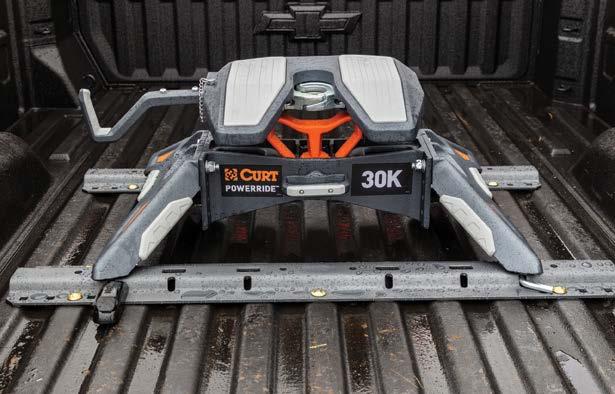
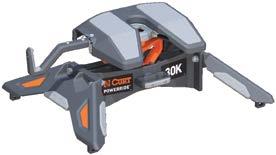
Once I discovered opposing living room slide layouts, I never looked back! That helped narrow our search and we were able to find the perfect RV for us pretty quickly. We compromised on the bedroom space so we could have a larger kitchen and living area. I’m so glad we considered the slide outs and layout first, because we have no regrets in our purchase.

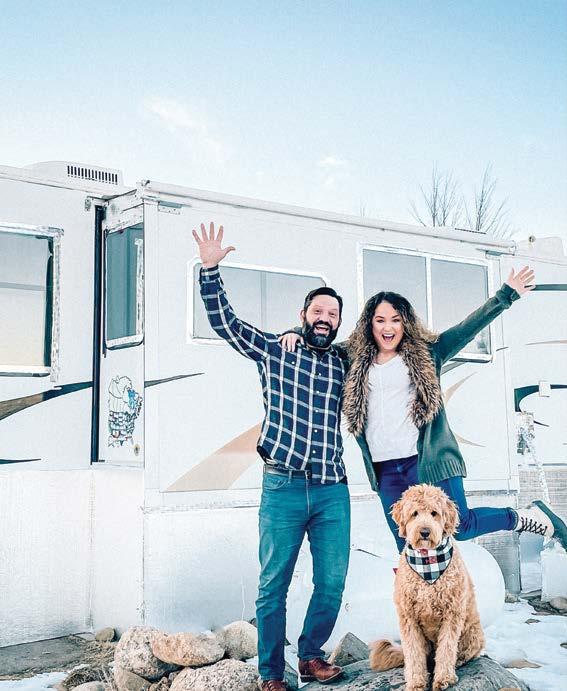 – Melinda Gonzalez and Jason Galjour @BayouDrifters
– Melinda Gonzalez and Jason Galjour @BayouDrifters
Slide outs—Often when you tour RVs, the slide outs will already be expanded, giving you the full interior space of the RV. However, it’s important to understand the complexity this adds to the RV’s setup and takedown process. Be sure to research the pros and cons before deciding if slide outs are a good fit for you.

Power options—Almost all RVs come with the ability to plug into shore power at a campground, enabling you to run all your appliances without concern for overloading your system or draining your auxiliary battery. If you want to camp off-grid, away from hook-ups, make sure you understand how big the RV power system draw is and what kind of solar system or generator you will need to run everything.
Towing—If you want to tow a vehicle for getting around to trailheads and shopping, decide what kind of vehicle you want to tow and then make sure the RV you want can handle it. On the other hand, if you’re using a truck to tow a fifth wheel or travel trailer, it’s imperative that you understand what your truck can handle.
Fresh, black, and gray water tank size —If you plan to stay in campgrounds, you won’t need to consider this feature as much, but if you want to boondock, you should understand how much fresh water you want to carry and how long it will last. In addition, knowing how much black water and gray water the RV can hold will give you a good idea of how long you’ll be able to go before you need to find a dump station.
Diesel versus gas—This may be a bigger consideration for some people than for others. While running diesel has its upsides, modern diesel vehicles require some fuel additives to stay environmentally friendly, and some RV owners may not want to deal with the upkeep. In addition, high-quality diesel fuel is not available everywhere, so if you’re planning to take your RV to Mexico, for instance, you’ll want to look into the potential impacts of using low-quality diesel in your rig.
Just because the trailer you’re looking at is less than the stated weight your vehicle can tow doesn’t mean it will work the true vehicle capability is the payload of the vehicle. That is the tongue weight for a trailer, or the pin weight for a fifth wheel, plus everything in the vehicle. To check payload, estimate all passengers and cargo in the vehicle and then take the gross vehicle weight rating of the trailer or fifth wheel. For a trailer, assume the tongue weight is 10–15% of the GVWR, and for a fifth wheel, assume the pin weight is 20%. Now add the passenger/ cargo weight and tongue or pin weight together and subtract from the vehicle payload found on the sticker inside the passenger door of the tow vehicle. If you exceed the payload, you have too much trailer for the vehicle, even if you are under the stated towing capacity.
– Stan Jessup FB: @salemmobilervSmart RV system—Many new RV manufacturers are joining the smart technology world and offering an app that allows owners to control the whole system from the convenience of their smartphone. You can pull your awning in, dim the lights, and turn down the heat while watching a movie from bed.
Backup camera—This may seem like an obvious feature, but not all backup cameras are created equal. The quality of your backup camera can have a huge impact on your ability to maneuver into places.
Gas mileage —Let’s be honest, we all wish RVs got better gas mileage. Considering the finite supply of fossil fuels and our carbon footprint, it’s important to research your potential RV’s gas mileage. And we’re not talking about just what the dealership says it gets—be sure to look online for actual RV owners’ experiences.
Security system—There are lots of security systems available for after-market installation on your RV. It’s easiest to have one in mind before you buy your RV, as some work better with certain RVs than others. Keep in mind that you may need Wi-Fi or internet connectivity to run a security system.
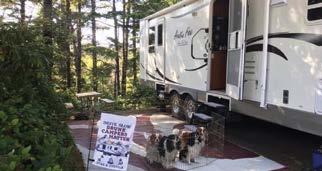
Consider your driving comfort level. Be sure to buy something you know you are comfortable driving. If driving a large vehicle is new to you, consider attending an RV driving school to learn more before buying.
Consult a buyers guide —The J.D. Power NADA RV guide can give you a good market-value estimation of most modern RVs. Even if you’re buying new, it’s a good idea to use a resource like NADA to see how an RV holds its value over time.

To combat the confusion of endless layouts, letters, and numbers, we went to the sales center three times; the first time was to just look and get a feel, the second time we went armed with a spreadsheet to help us record the features, and the third time I filmed the layouts with the RV name label as the first frame so we could mull things over. Once we got our heads around the details, we were able to decide what we needed and followed our intuition informed by our research!
– Matthew & Jemma Duke @viz.in.rv

Test drive —Do this as many times as you need to in order to feel comfortable with your purchase.
Since having our fifth wheel, we have had several things happen that needed repair under warranty. If we had read reviews of the dealer we bought from, we would have known that they don’t answer phone calls or respond to emails and that their customer service is lacking. We have definitely experienced this with them.
– Ashley Goebel @wanderingoilsRead reviews of the parts and service department—this will give you some insight into whether or not the dealer you’re shopping at is easy to work with.


Manufacturer warranties
Understand the warranties your RV will come with, both from the dealer and the manufacturer. For example, some of the components in the RV, like the fridge or heater, may be under warranty from the manufacturer rather than the dealership itself.
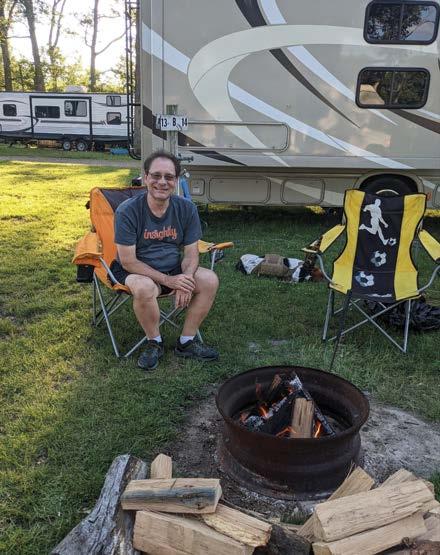
Check maintenance records—If you’re buying a used RV, the previous owner may have kept detailed records of any work they had done. Pore over those records and make sure you understand all issues that have come up in the past.
Whether you’re buying new or used, be sure to get a third party inspection. There’s a whole host of potential issues that can crop up in any RV, from mold to worn out tires, so the extra cost of an inspection is worth it.
 – Joe Testa @rvmentor
– Joe Testa @rvmentor
The majority of inspections I’ve done recently have been on new units and I’ve caught a few problems! For example, a really nice RV had two water leaks and an untested generator. Needless to say, it’s important to get brand new RVs inspected too.
Negotiate —Unless supply is really limited, there is usually some wiggle room on RV pricing. Never pay the full asking price, or see if you can get some upgrades or an extended warranty included in the full asking price.
Our fifth wheel is pre-wired for a generator, so we strongly considered installing a permanent generator in the front bay before we left. The upgrade would have cost $5,000 to $7,000. Instead, we decided to buy a used, portable dual-fuel generator for about $500. This provided us the opportunity to understand our camping style and power usage. Turns out, with the amount we boondock and what we use it for, the portable generator works like a charm!
–
Buy near your home —For the convenience of any future work that needs to be done on your RV, like winterizing or maintenance, it’s easiest if you purchase an RV from a dealership that is near your home.
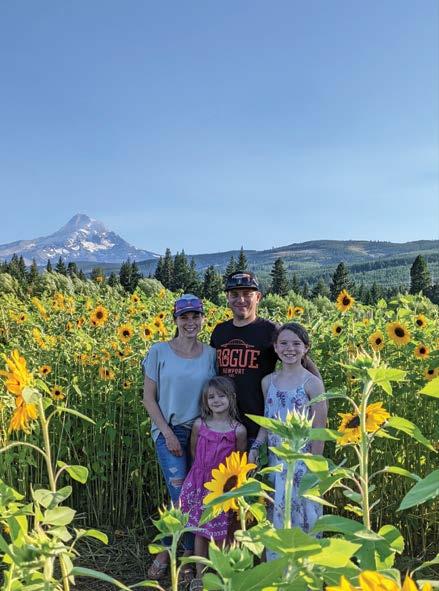
Ask questions! Take as much time as you need and ask as many questions as you need to feel comfortable.
Tax breaks—Research whether or not you can claim certain tax benefits from the purchase of your RV. For example, if you are able to claim it as a secondary home, you can write off the interest on your loan.

Upgrades—Understand the potential costs of added upgrades that you might need. For example, if you need to tow a vehicle with your motorhome, consider the added cost and make sure it’s within your budget.
Document your walkthrough—After the purchase, you’ll pick up your RV and do a walkthrough. This is to make sure everything is functioning properly, but also to show you how to use all the features in the RV. All that information can be overwhelming! It’s easier to take a video of the walkthrough so you can refer back to it later. ■



Planning a cross country road trip or staying local? No matter where your RV travels take you, RV Today readers are sharing some of their favorite campgrounds from around the country.

night $$ $31-$60 / night

$$$ $61+ / night
Full Hookups
Big Rig Friendly Playground
Dog Park Pool
Wi-Fi

Have a campground you’d like to share? Send an email with subject line “Campground Highlights” to collab@ RVToday.com for more information on how you can share a spot in an upcoming issue.


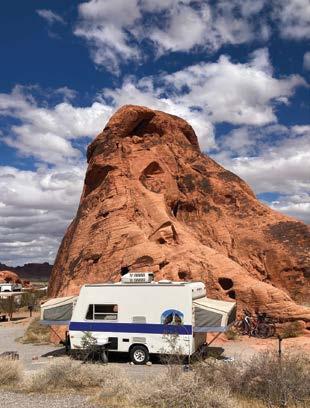
Moapa Valley, NV 89040

Atlatl Rock Campground is all about the views. Located within Valley of Fire State Park, the campground is surrounded by bright red Aztec sandstone outcrops. In addition to the jaw-dropping scenery, campers are often treated to sightings of bighorn sheep right in the campground. All campsites are first come, first served, so nabbing a spot is often difficult. For the best chance at securing a site, arrive early in the morning on a weekday. If you are unsuccessful, there are plenty of boondocking spots just a few miles down the road.
Atlatl Rock Campground is named for a boulder that sits near the entrance to the campground. The boulder, which is 50 feet off the ground and accessible via a large staircase, is notable because it is covered in ancient petroglyphs. One of these drawings is of an atlatl, a tool that was used to throw arrows and spears before the invention of bows.
The campground offers both primitive campsites and RV sites with water and electric hookups. There are bathhouses with hot water and flush toilets, as well as an onsite dump station. Cell service is spotty, but the park offers Wi-Fi for a fee. Campsite sizes vary, but the largest sites can accommodate RVs up to 50 feet long.
Valley of Fire State Park is a geological wonderland. The park is famous for its incredible red rock formations. Campers can hike the park’s short trails, and dogs on a leash are welcome to join their owners. Must-do trails include White Domes Trail, a 1.1-mile loop trail that wanders through incredible sandstone formations, and the Fire Wave Trail, a 1.5-mile round-trip hike that leads to a sandstone formation resembling an ocean wave with swirling patterns of red, white, and pink sandstone.
Alabama Hills, California, FREE

36.53754444, -118.1087469
This truly is a boondocker’s playground. While you won’t have hookups, you will have starry nights, endless hikes, and space to get away from it all. In the summer months it can be hot, but not unmanageable. This area is secluded but also offers an easy escape to views and cooler weather in the Inyo National Forest. There is so much to do in this area that you will probably want to stay for a few extra days!


Inyo National Forest is roughly a 30–45 minute drive from the Alabama Hills location, depending on which hike you’re interested in. This national forest offers astounding views, gorgeous mountain lakes, and cooler temperatures when you need them. Be sure to check out the town of Lone Pine as well—there’s lots of history in this little town that sits just outside the hills. Did you know the Alabama Hills have served as a backdrop for many movies, such as Iron Man and Gladiator? Don’t miss out on “Movie Road” while you’re there!
The Bureau of Land Management announced changes to dispersed camping in the area starting in October 2021, so be sure to check blm.gov for information before visiting.

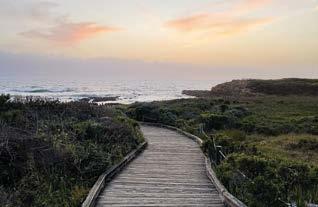
500 San Simeon Creek Road, Cambria, CA 93428


Hearst San Simeon State Park is a perfect location for those who want to feel like they are out in nature while camping, but not too far from civilization. The campground is surrounded by rolling hills and just a small walk away from the beach. The best part, though, is that the small town of Cambria is just
ten minutes south, and the beautiful Big Sur coastline is just about 30 minutes north via Highway 1. It’s the perfect location for a home base while you are exploring for a few days!
While Hearst San Simeon State Park does not offer hookups, the sites are close to a short path that leads you right to the beach. The parking slabs at the sites are also pretty large, so there was plenty of room to spread out and easily back in. Water spigots are available throughout the campground, as well as a convenient dump station. The maximum vehicle length for an RV is 35 feet. This campground is perfect for people with smaller rigs who do not need hookups and want to be nearly beachfront.

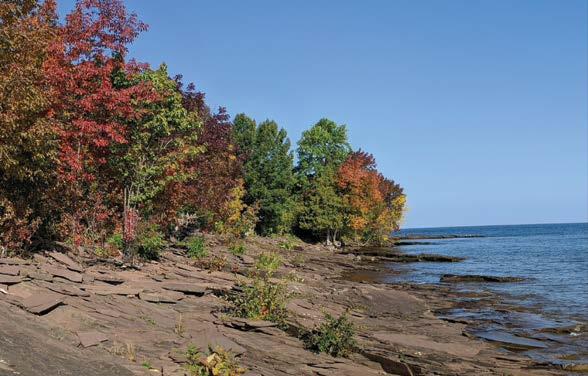
107th Engineers Memorial Hwy., Ontonagon, MI 49953
This is a typical state park in Michigan, where the sites don’t offer much privacy and are packed in more tightly than they should be. However, if you want amenities, this is a great base camp for day hikes in the Porcupine Mountains. It offers nice bathrooms and shower facilities, plus great views down by Lake Superior with plenty of access even if your site isn’t right on the shore. Be sure to check out the sunrises in the morning and stargaze in the really dark skies at night. Activities in the park include hiking, fishing, downhill and cross-country skiing, boating, disc golf, waterfalls, and wildlife viewing.

This park is huge, so you have to plan some travel time from Union Bay to the tourist sites like Lake of the Clouds and the many trailheads. Getting out and hiking in the park is the best way to appreciate its 60,000 acres.
Five must-dos in the park include driving up to Lake of the Clouds overlook, hiking the Presque Isle River Corridor, climbing the Summit Peak Observation Tower, visiting the abandoned Nonesuch Mine and ruins of the town of Nonesuch, and visiting the Wilderness Visitor Center for background and information about the park, its landscape, and its wildlife.

115 Meramec Park Drive, Sullivan, MO 63080
Whether you are driving through on Historic Route 66 or making this stop a destination, Meramec State Park has something for everyone. Located just 60 miles from St. Louis, Meramac is home to more than 40 caves, including Fisher Cave, which you can tour. It also has more than 13 miles of hiking trails along rolling forested hills, which offer varying scenery and water views around the park. The park also has access to the Meramec River, where you can float, kayak, or go fishing. There are three campground loops as well as cabin rentals and motel rooms. While visiting Meramec State Park, you should also plan to visit Meramec Caverns right down the road. Separate from the park, this cavern tour will take you more than a mile through underground caverns featuring the ancient Wine Table, one of the world’s rarest cave structures.

East 11th Street, Bayard, NE 69334
If you find yourself driving through Nebraska, be sure to stop by this city park offering free hookups in Bayard. Bayard is located a bit north of Interstate 80 near the Wyoming border, and the city park is in a quiet area. It can accommodate an RV of any size, with three level gravel spots available on a first come, first served basis There is water and electricity, but no dump at this park. Bayard City Park is very close to Chimney Rock and Scotts Bluff National Monument, making it a great base from which to visit those two locations.


Chimney Rock is a prominent geological rock formation rising nearly 300 feet above the surrounding valley. It once also served as
a landmark along the Oregon Trail. Scotts Bluff National Monument is composed of more than 3,000 acres of unusual land formations rising above the otherwise flat prairie. It features stunning views and hiking trails.

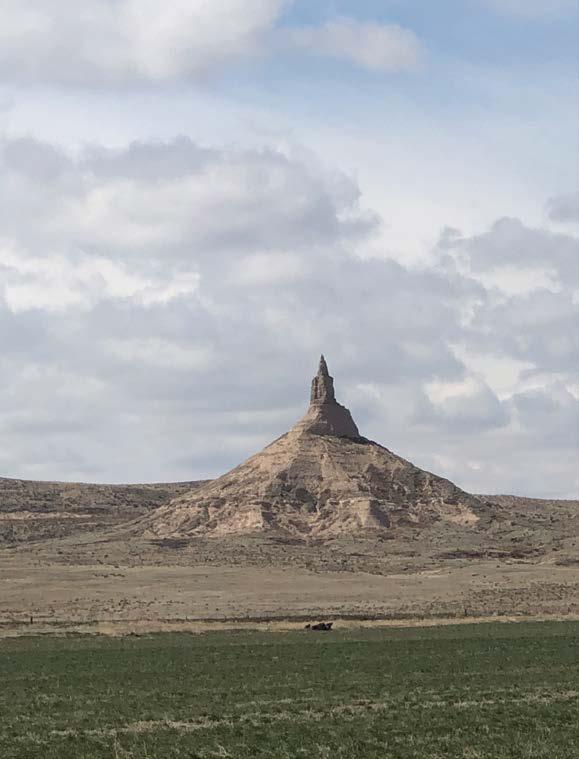

1080 Sawmill Hwy., Breaux Bridge, Louisiana 70517
If you are traveling through Louisiana along Interstate 10, Poche’s RV Park & Fish-N-Camp is a must stop. This RV Park is located off I-10, north of the small town of Breaux Bridge, Louisiana. The Cajun campground sits on 93 acres and has 85 full hookup sites. Every campsite has a concrete slab for parking, and the majority back right up to one of their five fishing ponds, so you can fish right out of the back of your camper or just a short walk away. Fishing here does not require a fishing license, and they are stocked with several fish species. If fishing is not your thing, they also have kayaks and paddle boats you can rent for a trip around the pond. Amenities include a pool, splash pad, and laundry facilities, and their store sells all the fishing bait and Cajun meats you might need. If you’re here on a Saturday night and hear music coming from their clubhouse, do yourself a favor and stop in for a great concert and Cajun dancing.

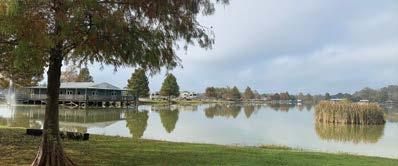

Poche’s RV Park is located five miles from the small town of Breaux Bridge, Louisiana. Breaux Bridge is the crawfish capital of the world, hosting a huge crawfish festival every May. The small town offers swamp tours, where you can ride airboats and see wildlife, including alligators. If you really want the Cajun experience, try out one of the many Cajun restaurants nearby—most also offer Cajun music and dancing. About ten miles away is the town of Lafayette, which also has Cajun and Creole history. There are a couple of living history museums and parks with costumed artisans where you can learn all about Creole history and culture.



1739 E Parkway, Gatlinburg, Tennessee 37738

Camp LeConte Luxury Outdoor Resort is nestled into the northern edge of Great Smoky Mountains National Park. Bring your rig or opt for the ultimate glamping experience in one of three retro Shasta trailers, a safari tent, or even a luxury treehouse. The campground also has primitive tent sites available. When making your reservations, look for their add-ons, including a birthday package, s’mores, and firewood. Whether you’re looking for a trip to the city or adventure in the great outdoors, Camp LeConte offers the best of both worlds.
There is no shortage of things to see and do in Gatlinburg, Tennessee, the gateway to the Smokies. The biggest draw to the area for outdoor enthusiasts is Great Smoky Mountains National Park, America’s most visited in the park system. From Camp
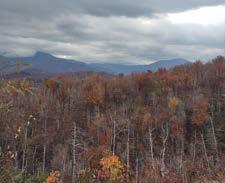
LeConte, it is 30 minutes to Grotto Falls inside the park, or one hour to Cades Cove Scenic Loop.
If you’re looking for a unique experience, you can make it to the record-setting Gatlinburg SkyTrail in less than 15 minutes. It’s the longest pedestrian suspension bridge in North America at almost 700 feet across, with 30 feet of glass flooring in the middle! Just 30 minutes away from Gatlinburg is equally scenic Sevierville, home to Emerts Cove Covered Bridge, a beautiful place to capture family memories.
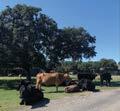
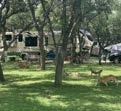

1218 Leibolds Point, Lakehills, Texas 78063
You’ll find Lake Medina RV Resort in the beautiful Texas Hill Country. This campground is located 45 minutes outside San Antonio, on Medina Lake, and is a quiet place to retreat after touring the big city. The campground is located on a 700-acre working ranch, with horses and cattle. The ranch was purchased in 1882 and has been passed down for six generations, with three generations living on and running the campground today. The staff are friendly and helpful and give the campground a homey feel, which makes coming back easy.
While staying, be sure to head into San Antonio, which is home to the Alamo as well as four other historic missions. There is also the famous Riverwalk, which is located just across from the Alamo. The Riverwalk offers many restaurants, bars, hotels, shops, and cultural experiences. There is a historic boat tour you can take to learn all about the river and San Antonio. The city is also full of museums, wineries, breweries, and ghost tours, as well as home to Six Flags Fiesta Texas and the San Antonio Zoo.

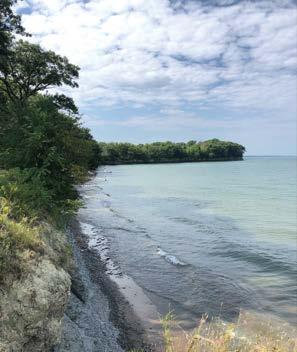
10191 Old Lake Shore Road, Irving, NY 14081

Located on Lake Erie, Evangola State Park is a beautiful place to relax and enjoy New York. While its main attraction might be the sandy beach, it also has baseball diamonds, basketball and tennis courts, biking and walking trails, and a nature center. The nature center is located in a 1929 YWCA recreation building with plenty of history of its own. The park features three different campground loops—two with electric hookups and one tent camping loop. There is water available throughout the park, and a dump station.
If your RV is more than 12 feet tall, beware! There is a 12-foot, 6-inch overpass located on one of the main ways to the park. Be sure to use your favorite RV or truck maps to guide you around or you may end up backing up along the road!
Evangola State Park is located just 45 miles from Niagara Falls, so be sure to make the most of your New York stay and visit this iconic waterfall.
216 W Main Street , Searsport, ME 04974
This oceanfront campground is well maintained and has a family feel. It’s located on the shores of Penobscot Bay between Bar Harbor, home to Acadia National Park, and Camden Village


As you pull into the property you may see goats, handmade wooden outhouses, playgrounds, and art that make it all the more welcoming. There are a few full-time RV residents onsite, but everyone is friendly and the campsite is clean. The owners are responsive and happy to share RV advice.
You might enjoy beautiful bay views from your site, and there are family-friendly summer activities including crafts, games, bonfires, and lobster boils. Other amenities include hot showers, coin laundry, and clean communal restrooms. The shore is several feet from the campsites and is a popular spot for walking or partaking in water sports. If you have time, Islesboro is a short ferry ride away and is visible from the campground.
Bar Harbor and Acadia National Park are about 50 miles east of the campground. Acadia is the biggest attraction in the area and a must-see if you’re there. There are countless opportunities for hiking, outdoor activities, and exploration.
Though there isn’t much entertainment in the immediate area surrounding the campground, Camden and Rockland in Penobscot Bay are a short drive south. They have restaurants and many options for day sailing trips, shopping, and other activities.

12550 Eagles Nest Road, Berlin, MD 21811
This campground is paradise. You would never guess you’re on the East Coast because it feels like you’re on a tropical island. One of the best things about this campground is all the amenities—there’s enough to do that you don’t ever have to leave the campground itself! You can go to the beach and then walk over to the bar and have a drink, including live music on the weekends. There is a small beach specifically for dogs with a dog wash station, plus a fitness center, mini golf, and much more.
A short drive from the campground is the bustling beach town of Ocean City, Maryland. There are several restaurants and shops to explore. It’s also just minutes away from Assateague Island National Seashore, which is absolutely stunning. If you’re lucky, you might even see wild horses roam the beaches! ■
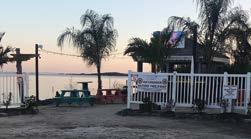
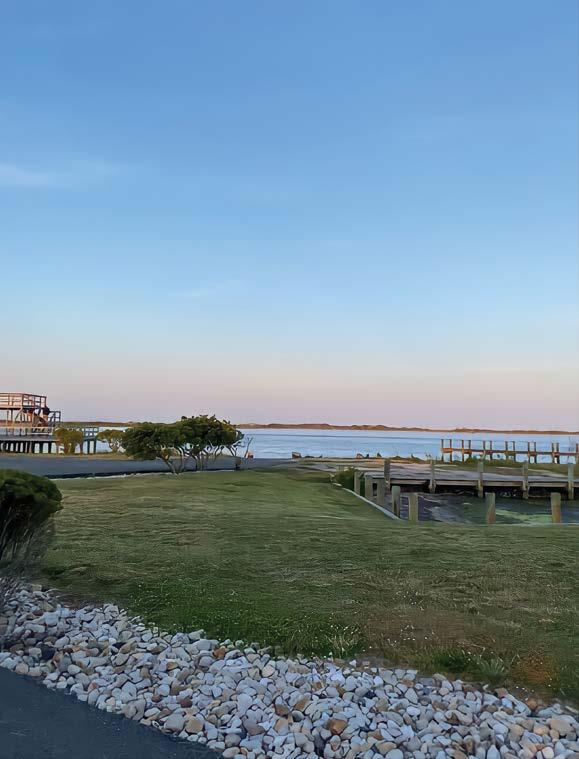 Contributed by Danielle Isermann
Contributed by Danielle Isermann
Just like every great road trip, sometimes life takes you in a new direction. At Heartland, we’ve launched a new journey to make our RVs better than ever. We’ve doubled down on seeking out the highest quality materials, creating fresh and inviting interiors and giving every unit the kinds of finishing touches you’d find in a new home.
Every unit goes through a top-to-tails inspection with a quality assurance expert—in fact, we have an 89,000-square-foot facility dedicated to walking each RV through a series of checklists to ensure it works exactly as it should. And with updated floor plans incorporating features our customers love best—spacious bathrooms, designer kitchens, furniture meant for cuddling up together—we’re confident every trip in a Heartland will be a happy one.
After all, that’s what RVing is all about: hitting the road with people you love, having adventures, making memories. So when you buy a Heartland, just focus on taking the journey of a lifetime. We’ll take care of the rest.
Experience the all-new Heartland online and check out 360-degree model tours, detailed floor plans, all-new features, galleries of updated decor and more.
Just visit HeartlandRVs.com.
















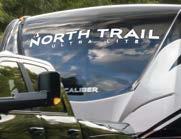
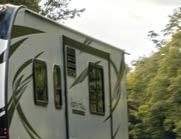


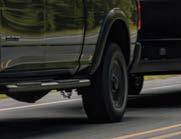










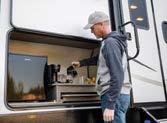
Delaware might be the second-smallest state in the country, but what it lacks in size it makes up for in natural beauty, outdoor recreational opportunities, and historical sights. Located on the Delmarva Peninsula along with portions of Maryland and Virginia, Delaware’s eastern shore consists of dune-backed beaches along the Atlantic Ocean, Delaware River, and Delaware Bay.
State parks are always a favorite destination of ours when traveling, and Delaware is no exception. Five of its 17 state parks boast family-friendly campgrounds with RV and tent sites as well as cabin rentals. With its coastal location, World War II history, renowned bird watching, and numerous trails that weave through rolling dunes, Cape Henlopen State Park is a true gem.

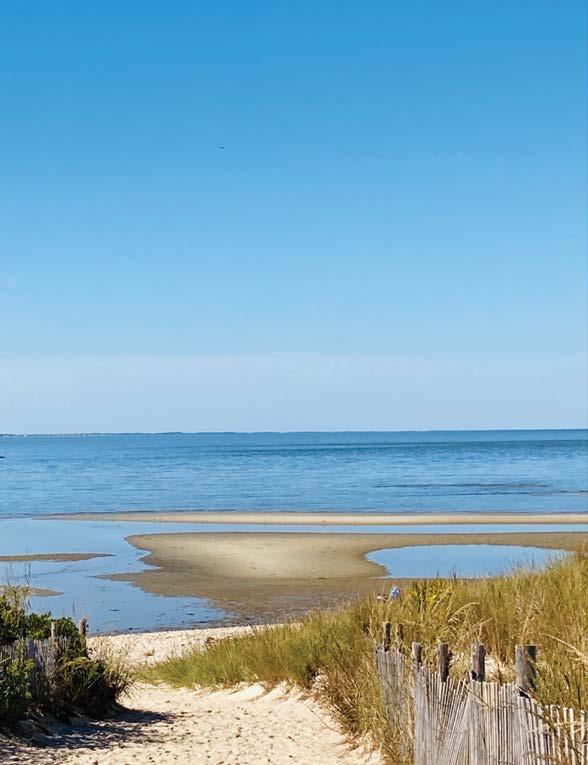

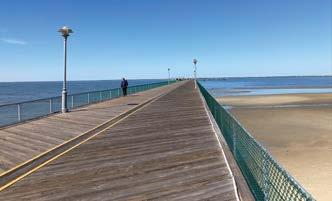


WHEN TO GO: The park is open year-round, and there really is no single best time to visit. It all depends on your preferences. Obviously, its beach location means the summer can be crowded, humid, and buggy. Winters are reasonably mild, with average high temperatures in the upper 40s to low 50s from December through February. Late spring and early fall have warm enough weather to allow sunbathing, beach walks, and ocean dips with a little more solitude.
HOW TO GET THERE: Cape Henlopen State Park is easily accessible via well-maintained two- and four-lane state roads. Regardless of where you are traveling from, the final few miles will be on Route 9 East, Freeman Highway, which is the only access point to the park. The well-marked park entrance is approximately 1 mile past the Cape May-Lewes Ferry terminal.
WHERE TO STAY: The park’s campground is wellmaintained, with an easy-to-navigate one-way traffic pattern, two shower houses, a laundry room, and a camp store. Several hiking and walking paths to the beach and other sites in the park have access points at the campground. The Delaware state park system uses Reserve America to book campsites. We like this system because it allows you to search site size and availability by date and location in the campground.
RV CAMPING: Cape Henlopen is a terrific destination for RV travelers. It has 120 RV sites with water, electricity, fire rings, and picnic tables. All but 10 of the RV sites are back-in. Be sure to check the size limitations when booking your reservation, because while some of the sites are big rig friendly, the majority are restricted to vehicles 35 feet and smaller. The campground also has a large dump station with two lanes that is easy to access regardless of RV size.
TENT CAMPING: Two tent loops offer a total of 43 tent camping sites. Many tent campers also book the small RV sites to have water and power access.
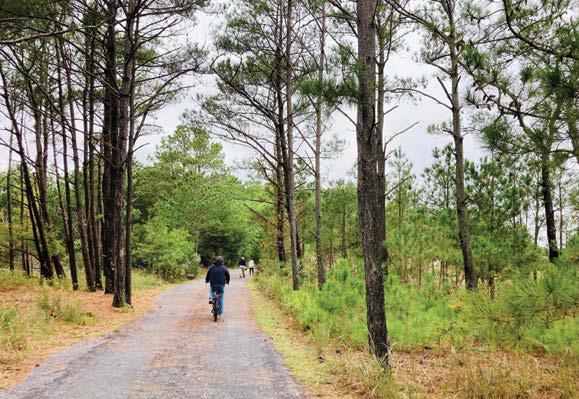
CABIN CAMPING: Cape Henlopen has 12 cabins located in a secluded area at the edge of the campground. These cabins offer a queen bed and sofa in the front room and two bunk beds in the rear room, and pets are not allowed. Other amenities include:
☐ Screened porch with dining table
☐ Heat and air conditioning

☐ Compact refrigerator
☐ Outdoor grill and picnic table
☐ No indoor water source, but drinking and cooking water outside
☐ Restroom and shower facilities at the nearby bathhouse
THINGS TO DO: Located at the point where the Delaware Bay meets the Atlantic Ocean, Cape Henlopen boasts 7,000 acres of natural wonders, including 6 miles of coastline with abundant recreational opportunities.
BEACHES: Gentle dunes and shorebirds beckon visitors to Cape Henlopen’s beaches with numerous access points and parking areas for the ocean and bay shoreline. The Point Overlook is a great place

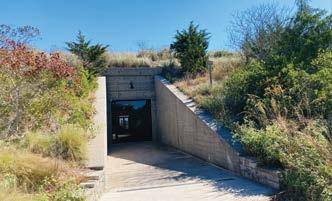

to get a lay of the land. You’ll also see the East End Breakwater and Harbor of Refuge lighthouses.
In winter, visitors can hike around the Point on the bay and ocean beaches. However, that portion of the beach is closed from March through October to protect threatened and endangered beach-nesters and migratory shorebirds. If you’re visiting during that time, there are still plenty of other options for beach lovers
The park even has two designated swimming beaches, with lifeguards on duty between Memorial Day and Labor Day. The northern swimming beach offers showers, changing rooms, and concessions. It is also wheelchair-accessible from the boardwalk.
BIRD WATCHING: The area’s mid-latitude coastal location offers an endless procession of migrant birds throughout the year. Over at the Point, where the bay meets the ocean, shorebirds abound, including red knot, piping plovers, oystercatchers, least terns, and other species.
One unique feature of the park is the Cape Henlopen Hawk Watch operation, held from Sept. 1 to Nov. 30 each year. Volunteers count and report the numbers of passing raptors, including red-tailed hawks, red-shouldered hawks, broad-winged hawks, Cooper’s hawks, sharp-shinned hawks, bald and golden eagles, turkey vultures, black vultures, kestrels, merlins, and peregrine falcons.
BIKING OR WALKING: The park offers more than 17 miles of paved, crushed stone, and hard-packed dirt trails that allow riders to experience dynamic coastal habitats, including sand dunes, maritime forests, and tidal wetlands.
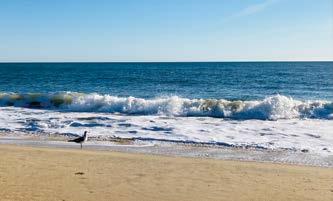
Park Loop Trail: This 3.3-mile paved trail loops around the Seaside Nature Center, Fort Miles Historic Area, and Main Beach.
Gordon’s Pond Trail: The popular out and back trail is 3.2 miles each way. Three overlooks provide views of ocean dunes, tidal marshes, and Gordons Pond. It’s a great place to view wading birds in the pond during summer and waterfowl in winter.
Walking Dunes Trail: A 2.6-mile trail loop of primarily crushed stone traverses the quieter side of the park It features low boardwalks through a marsh and a single-track trail through the forest.
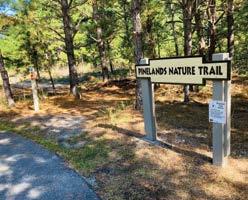
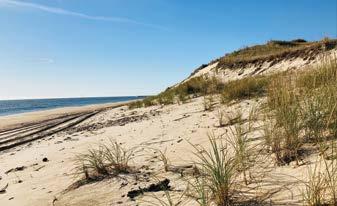

Junction and Breakwater Trail: This 5.8-mile stone dust and paved trail follows portions of the old Junction & Breakwater Railroad, allowing campers to bike directly to Rehoboth Beach from the state park. Rehoboth Beach is perhaps the most well-known beach in Delaware, and it is often billed as “The Nation’s Summer Capital.” It’s been a resort city since the 1870s and remains a desirable getaway with its sophisticated restaurant scene, wide and clean beaches, and historic boardwalk—plus great tax-free shopping.
FISHING: Fishing opportunities abound at this destination. Anglers have their choice of fishing from a pier on the Delaware Bay or in the surf. The quarter-mile-long pier provides access to the Delaware Bay. There’s even a bait and tackle shop off the pier where you can find all your fishing necessities, as well as purchase licenses and snack foods, from April 1 through Oct. 31. Surf fishing is popular and the park has dune crossovers that allow
both vehicles and pedestrians to get to the beach’s designated fishing areas. A surf fishing vehicle license is required to drive on the beach.
SEASIDE NATURE CENTER: The nature center is a great educational opportunity to learn about local reptiles, fish, and other marine organisms. There is a touch tank where you can find horseshoe crabs, whelks, and more. It’s a great place to start your visit by viewing the park map, talking to a knowledgeable naturalist, and renting bikes for free from the bike barn.
HISTORY: A stay at Cape Henlopen would not be complete without learning about its historical significance. It was once Fort Miles, a World War II military base responsible for protecting the Delaware Bay and River from enemy warships. Many historic structures, such as the fire control observation towers, still stand, remnants of a once-active World War II coastal defense system. Active from 1939 to 1942, the towers allowed the U.S. military to keep an eye out for adversaries approaching the coast. Inside the towers, observers used rangefinders and triangulation to determine the location of suspected enemy ships and pass it to the gun batteries. Today you can
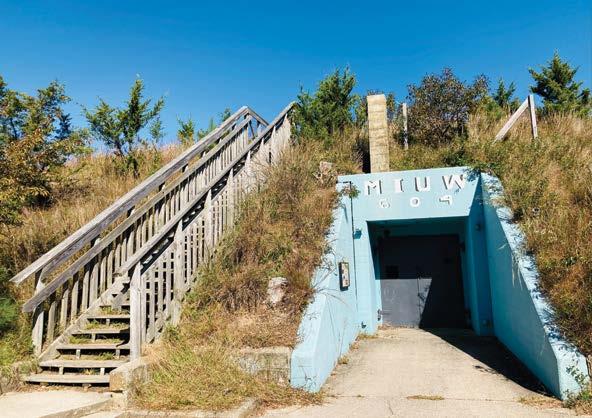
walk through the area and see several remaining barracks, a gun battery, and an artillery park. The museum hosts artifacts within Battery 519, a 15,000-square-foot fortified underground chamber. ■
About the Author
Julie and her husband Sean started traveling in their RV full time seven years ago, after they each served 20 years in the U.S. Air Force. Having lived in more than 10 states and four countries, the Chickerys decided it was time to enjoy the rest of the United States. Julie manages Chickery’s Travels, an educational and inspirational blog and YouTube channel aimed at helping people realize their RV travel dreams. Follow them on Instagram @chickerystravels.


● Established as a national recreation area in 1974
● No entrance fee
● The country’s 7th most-visited national park in 2020
● Naturalists have found 943 plant species in the park
● The Cuyahoga Valley is an example of ecological management as it used to be known for air and river pollution
Just a quick drive from some of Ohio’s largest cities lies Cuyahoga Valley National Park, a 33,000-acre historic and natural area that may be close to the hustle and bustle of city life, but feels worlds away.
With a variety of things to see and do, including waterfalls, beautiful trails, local farms, canal history, and exploring by bike, kayak, or train, Cuyahoga Valley is unlike any other national park in the United States and makes for a fun and unique adventure!

The area that now makes up Cuyahoga Valley National Park has been explored for thousands of years, starting with a few different Native American tribes.
In the late 1700s, settlers made their way to the Cuyahoga Valley from areas of New England, and by the 1830s, the Ohio and Erie Canal ran through the valley, connecting the Ohio River with Lake Erie and creating an inland water route between the East Coast and the Gulf of Mexico.
In 1974, Cuyahoga Valley was designated a national recreation area, despite some pushback due to the river’s pollution at the time. After some cleanup efforts, it was upgraded to a national park in 2000, making it the 56th U.S. national park.
The park is located in northeast Ohio and is less than 30 minutes from Cleveland and Akron, which both have airports, making it a very accessible park to visit. It’s also close to many major highways that go through the Midwest and East Coast, so it’s a perfect road trip stop when driving across the country.
One of the best things about Cuyahoga Valley National Park is that it’s open year-round and every season provides a different experience.
Spring: Spring is the perfect time to visit the park if you want to see the waterfalls at their best, as the snowmelt and rain causes them to flow at a much higher rate than other times of the year.
Summer: Visiting in the summer will bring peak crowds and warmer, humid weather, but it also provides the most activity options, with farms open for the season, as well as the train running a full schedule.
Fall: Fall brings crisp days, foliage, fall activities, and less crowds than the summer season. While the waterfalls may not be as powerful this time of year, the fall scenery in the park is beautiful and many of the top attractions are open through October.
Winter: In the winter, the park turns into a winter wonderland, with snow covering the park’s trails and surrounding the waterfalls. This is a great time to experience the park without crowds and try some winter activities, such as cross-country skiing, tubing, and sledding.
There isn’t a campground inside of Cuyahoga Valley National Park, but there are a handful of RV parks and campgrounds near the park, such as the Silver Springs Campground and a KOA.
If you plan to explore the greater area, Cleveland or Akron would be a perfect home base and offer a variety of lodging options, including hotels and Airbnbs, plus campgrounds on the outskirts of both cities.
Looking for a free spot to boondock? The Cabela’s in Avon, Ohio allows overnight parking and is only 45 minutes from the park.
It’s free! Unlike most national parks, which can cost between $20 and $35 per vehicle to visit, Cuyahoga Valley National Park is totally free!
Dogs are allowed on trails: In Cuyahoga Valley, leashed dogs are allowed on the park’s trails, which is rare in a national park!
RV parking is limited Most parking lots at Cuyahoga Valley do not offer designated RV parking. There are some places where RVs can park, such as at the visitor center, Canal Exploration Center, and a few trailheads, but for the most part, the parking lots are designed for regular vehicles, although most can fit up to a Class B as well.
There is no park shuttle: Cuyahoga Valley National Park does not have an official park shuttle, so you’ll need your own vehicle or a bike in order to explore the park. You can bike in and around the park along the towpath trail, which we will share more about below.
Brandywine Falls: Brandywine Falls is one of the most popular sights at Cuyahoga Valley National Park. This 60-foot waterfall is accessed by a quick walk down some boardwalks and stairs, which leads you to a couple of overlooks. To add to the adventure, you can hike the 1.5-mile Brandywine Gorge Trail, which takes you along the gorge and down to the creek.
Ledges Trail: The 2.3-mile Ledges Trail is an essential hike at the park and takes you alongside the Ritchie Ledges, a series of impressive rock formations tucked into a forest.


While on the trail, be sure to pay close attention to side trails that will take you to hidden slot canyons and nooks where you’re surrounded by rocks and moss, which feels like something out of a fairytale.
Blue Hen and Buttermilk Falls: Blue Hen Falls is another beautiful waterfall to check out, as long as you don’t mind a bit of a hike. At 3 miles round trip, this hike takes you to a picturesque 15-foot waterfall that flows off the side of a sandstone cliff. For an additional mile round trip, add on Buttermilk Falls, a 30-foot waterfall that cascades down a tiered rockface.
Brandywine Falls Ledges TrailBike the Towpath Trail: As we mentioned earlier, the Ohio and Erie Canal played a big role in this area’s history, and today you can experience part of the canal on the towpath trail, which is an 87-mile pathway, with 20 miles going through Cuyahoga Valley National Park.


This trail takes you along the same path that mules walked as they towed canal boats loaded with goods and passengers back in the 1800s, and is accessible by foot, bike, stroller, or wheelchair.
We highly recommend riding bikes along this pathway, and if you’re in need of a bike rental, Century Cycles in Peninsula is a great bike shop.
Ride the Cuyahoga Valley Scenic Railroad: The Cuyahoga Valley Scenic Railroad has been going through the valley since 1880 and today offers scenic 3.5-hour railroad trips between May and October, as well as themed train rides during other times of the year.

One unique option on the train is to bike, kayak, or hike aboard! This means you take the train one way and your other preferred method of transportation the other way. During our visit to the park, we biked from Peninsula down to the Beaver Marsh and then took the train from Indigo Lake back to Peninsula. It made for such a fun experience in the park!
Visit a Farm: Something else that makes Cuyahoga Valley unlike any other national park is that there are many farms both in and around the park. Some fun farms to visit are Szalay’s Farm & Market for corn and a variety of local produce and treats, Greenfield Berry Farms for blueberries, and Countryside Farmers Market on Saturdays to support many vendors!

Indigo Lake: This small but scenic lake is a great picnic pit stop when riding the Towpath Trail, with a few tables and plenty of grass to sit on.

Beaver Marsh: The Beaver Marsh is a perfect example of how nature can be restored after damage from human intervention. Back in the 1800s, this area was a wetland, but it was drained when the railroad came through. Part of the land was used as a dairy farm and part as an auto body shop, with car parts littered everywhere.
In 1984, the area was cleaned and beavers started to return to the valley. They built dams, which flooded the area and restored natural water levels, allowing plants and diverse wildlife to return.
There is now a nice boardwalk that goes across the marsh where you can see tons of lily pads, plants, and if you’re lucky, wildlife.
Everett Road Covered Bridge: This red covered bridge was built in the 1800s and makes for a great, quick photo spot when visiting the park.
Hale Farm & Village: Hale Farm & Village is a living history museum that shares 19th century life through demonstrations, gardens, animals, and 32 historic buildings. There are costumed interpreters to share the story of what life was like and help transport you back in time.
Canal Exploration Center: To learn more about the history of the canal and its impact on the area, visit the Canal Exploration Center! Here you’ll be able to see a lock, learn the importance of mules, and interact with different exhibits. Note: Although this museum is located inside the park, it is run by a separate organization and has an additional fee.
With hiking, biking, trains, waterfalls, farms, and so much more, Cuyahoga Valley National Park is a unique park experience and we hope you enjoy its variety, history, and scenery as much as we did! ■

In 2016, our family of four sold our house and 90% of our belongings and hit the road in our RV. We gave up all the comforts of a conventional life for the adventure of a lifetime. At the time, it definitely wasn’t unheard-of to find other full-time nomads on social media, but to actually run into each other on the road was hit-or-miss. In fact, it was so rare we almost gave up—we were having so much fun, but we were longing for community.

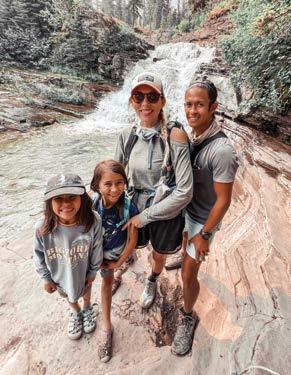
Fast-forward to the dumpster fire that was 2020. Who could have possibly predicted the market explosion that hit the RV industry? At our current campground in Palm Springs, if I threw a rock, not
only would I hit another full-timer, but it’d bounce off their RV and hit another full-timer. As OG full-timers, watching this influx of new RVers has been both inspiring and concerning.
Let me explain. We absolutely love our nomadic community. In the best way, everyone out here on the road is just a little off. For whatever reason, the conventional lifestyle wasn’t for them, so here they are—out here with us in the campgrounds, the national parks, and the “super-top-secret, insider-only” coordinates. We love connecting with these other nomads and hearing their stories.
So why is it concerning? Well, while the influx of community has been profoundly refreshing, it also means less-crowded camping experiences are more challenging to locate.
The key word there is “challenging”—note that I didn’t say “impossible.”
The quote, “It’s not gonna be easy, but it’s gonna be worth it,” comes to mind, but in truth, it’s actually easier than you might think! The trick is having the right resources available to you.
In the summer of 2020, we decided we needed some “social distancing.” We headed up to one of the more remote places we could think of—Michigan’s
Upper Peninsula—and quickly realized many others had the same idea. Rather than abandon our plans, we got resourceful. We had used apps like Campendium, RV Trip Wizard, and RV Parky here and there, but hadn’t really used them to their full capabilities.
When we began to really dive into those resources, we found there are amazing and unique camp spots that not only provide stunning views, but also extraordinary one-off experiences. Through almost laughably inexpensive programs like Harvest Host and Boondockers Welcome, we’ve had some of the most memorable and meaningful stays.

Somewhere between the petting zoos, apple cider mills, solar farms, private lakeside beaches, and mountaintops with views of the Grand Tetons, you’ll find us connecting as a family, having outdoor movie nights, playing Uno, or doing family watercolor painting, often without another soul in sight or, perhaps more importantly, without another generator in earshot!
So what else do you need to be able to enjoy these incredible camping opportunities? Finding them is only half of the equation. Thriving in these situations is the other half. Whether you’re in a pop-up, a diesel pusher, or a large toy hauler, you’re dealing with the same limitations—water, sewer, electricity, trash, and connectivity.
Your potable water and black water needs will depend on the size of your RV’s holding tanks. Locating places to fill up and dump wastewater near your location is as easy as checking the apps I mentioned above. Another fantastic resource is freecampsites.net.
Electricity is the resource that gets the most attention. In that regard, it’s a great time to be an RVer. Quiet inverter generators can be had for around $350, and uber-efficient lithium batteries are coming down in price. There are so many options in powering your RV that it’s worth its own article.

Trash tends to be a burden that goes overlooked. We pack out our garbage while we’re exploring the area. If we fill up on fuel that day, I’ll throw the garbage away at the gas station. If we’re visiting a nearby state park, the entrance fee typically includes access to their dumpsters.
Considering connectivity tends to elicit sneers from the camping purists. While I’d love to live in a world where constant connectivity isn’t a necessity, the bottom line is that most of us aren’t trust fund babies or lottery winners. We’re everyday people who need to check in with the office, or log our kids in to their Outschool.com classroom.
We currently have data plans with three different cell phone carriers. We’ve found that our AT&T and Verizon plans have provided us coverage in some of the most unexpected places. I think watching “Close Encounters of the Third Kind” outside on the movie projector with Devil’s Tower National Monument in the background was one of our more memorable experiences.

I hope you can learn from our victories and mistakes! Keeping secrets has never been our thing—the world is too big and beautiful, and there’s so much out there for anyone who dares to look for it. We are so excited for anyone who decides to make their own lives their living adventure, and we feel this urgency to help any and all who enter this lifestyle. ■
About the Author
Nate Axness is a full-time digital content creator at projectreklife.com, where he, his wife, and their two children share their unique lifestyle. He’s passionate about helping other families experience the benefits of long-term family travel. Follow them on Instagram and TikTok @projecttrek and subscribe on YouTube at Project Trek. Coined “the mayor” by his friends, you can often find Nate on the side of someone’s RV troubleshooting a problem, or under their RV showing them how to clean their black tanks.
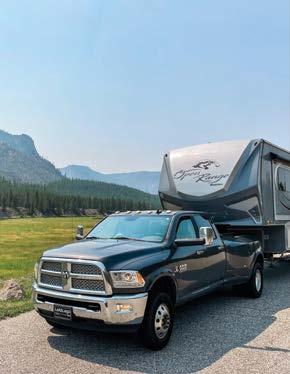
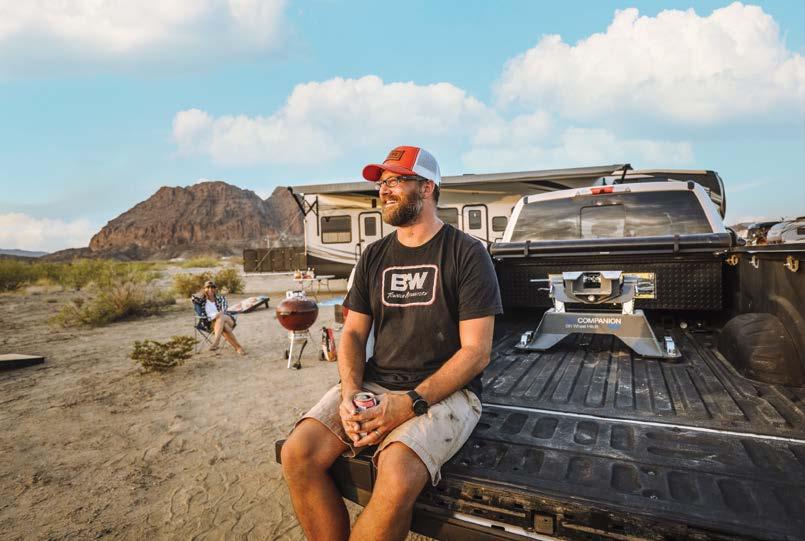











RVing can be an exciting and adventurous experience, but many times it’s not without a little bit of chaos. And sometimes these misadventures can be more than we bargained for. Here are three stories from RVers who found themselves in difficult, unexpected, and very memorable situations.

Driving into Mexico for the first time as full-timers was a big deal. We knew the border crossing would be tedious, but we had everything planned out … or so we thought. What started out as an exciting adventure ended up being one of our most memorable misadventures.
The border crossing into Baja California, Mexico went smoothly through the X-ray inspection process. But we were in for a surprise when we tried to start the truck back up. After turning the key, the ignition pin broke off in the ignition cylinder and the key just kept spinning. Our truck would not start and we were stuck at the border!
Somehow we had cell service and Blake immediately started trying to figure out the problem, watching YouTube videos about how to fix it. The border agents were getting impatient with us and Blake, who is thankfully fluent in Spanish, explained what happened to our truck. The border
agents gave us half an hour before they started threatening to tow us out of there. Several agents even hopped in the vehicle to try to start the truck with a screwdriver.
Unfortunately, since the broken pin was stuck in the cylinder, their trick didn’t work. With only a few minutes left to spare of our generous half-hour, Blake got creative and tried attaching a screw into the broken pin stuck in the cylinder, then turning it with the screwdriver to start the truck—and it worked!
The next challenge was not stalling or turning off our manual truck until we
could fix the issue, because that trick was probably only going to work once. The nearest AutoZone was half a mile away back in the United States and had the part we needed, so our only options were to try every auto part store in Tijuana or to recross the border back into the U.S.
We waited in line for four hours to cross back into the U.S., managing to not stall the truck once. We told the border agent our story and she let us through immediately without any additional inspections.
Within 10 minutes of being back in the U.S., we got to the AutoZone and purchased and installed the $25 part. We continued our trip into Mexico and spent the next three months and 2,000 miles exploring the Baja California Peninsula without breaking down.
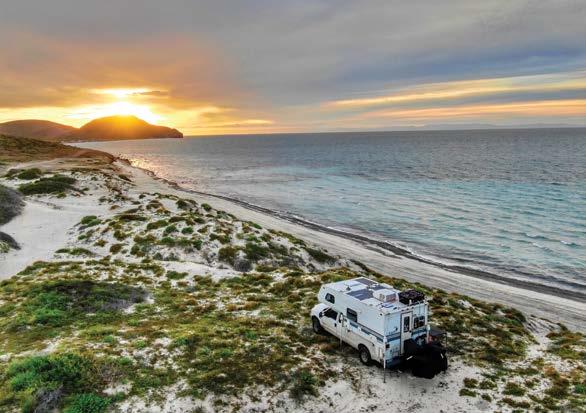 Blake Scott and Rachel Firmin @thisisnomadic
Blake Scott and Rachel Firmin @thisisnomadic
It was a dark and rainy night outside of Wanaka, New Zealand, and we were on our way to one of the few free camping areas near beautiful Lake Hawea. As we approached a classic New Zealand one-lane bridge with the right of way, we noticed a vehicle approaching from the other side of the bridge. We fully expected the oncoming car to yield and let us pass, but instead heard their engine revving and saw their headlights approaching faster and faster.
Dani slammed on the brakes, but it was too late, too wet, and our low-budget tires were very bald. We slid out of control, completely sideways, toward the bridge. Our front bumper sideswiped the aggressive car, sending it into a ditch. The oncoming vehicle never stopped; it went into a gully, up a hill, and back onto the road, and drove until the vehicle seized. It looked like a scene out of Dukes of Hazzard.
We got out of the van in the pouring rain, thinking our lovely New Zealand vanlife adventure had come to an end since we had the most basic insurance coverage available, only to see that somehow, we escaped with minor damage to our front bumper. I wish I could say the same for the other vehicle. We approached the vehicle and saw a very young traveler throwing empty beer cans into the woods and asking, “Who did I hit? Who did I hit?” Taking in the

busted windshield and glass everywhere, we realized just how drunk he was and informed him that he hit us.
He told us the car wasn’t insured, he didn’t have a license, and he paid $500 for the car, and that he was just on his way to the bar. It was late and rainy and there were no other witnesses to call the police. We told him his vehicle was probably totaled and with that, we can pay for it rather than go through insurance. He kept telling us it was a $500 car and he didn’t want to deal with a report, probably because he was drunk.
As I talked to the passenger who was with him, I noticed the young driver was pushing his car off the road down into a ravine, where he would never be able to retrieve it without the help of a tow truck. As we discussed options for what to do about the car, the driver said, “Just give us a ride to the bar, mate, and it will be all good.” I said, “Perfect! Let’s get out of here before the cops come.” We jumped into our van and headed back to Wanaka to drop them off at a bar.
Within five minutes of being in our van, he was lighting a cigarette and talking as if the car wreck had never happened. He asked us where we were from and what we were planning on doing for the night. We arrived at the bar and he asked if we wanted to have a round of drinks on him for the ride to the bar—not even mentioning all the chaos that just ensued. We politely declined since we were just trying to escape this nightmare of a night. We kicked them out of the van and turned back toward the campsite as quickly as possible.
As we arrived at the campsite, the rain subsided and the weather cleared, which is very rare in New Zealand. We got to witness the Aurora Australis, also known as the southern lights, at Lake Hawea! We had never seen anything like it. It was a beautiful experience. Looking back, if we had never had the incident, we would have arrived at the campsite, gone to sleep, and missed the southern lights.

If we learned anything from this misadventure, it was that driving at night in the rain isn’t the safest thing to do, especially in another country, and especially when you are driving your home. It was a crazy night and made for an even crazier story.
Kevin Arnold and Dani Dukes @vankookz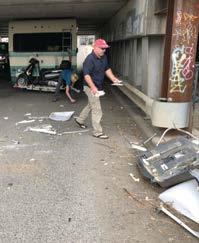
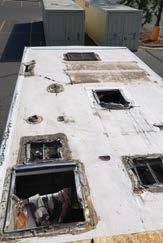
We were heading to Canada to take our RV out of the United States for the first time. A friend joined us for our journey, and she had only been with us for a few days when it happened. My husband was driving and turned left under an unexpectedly low bridge. We had made it about halfway under when the sound of grinding metal filled our ears, we suddenly jolted, and then we were stuck! We had driven our RV right under a bridge that was too low and we did not fit through. Our air conditioner, fans, vents, and solar panels were ripped off the roof.
Unfortunately for us, the height restriction sign was bent over so you couldn’t read it, and there were no other warnings of a low-clearance bridge. The officer told us it happens all the time, which offered little relief. We aired our tires down in order to get out from under the bridge, and a local offered to haul off the parts of our RV that now lay on the side of the road.
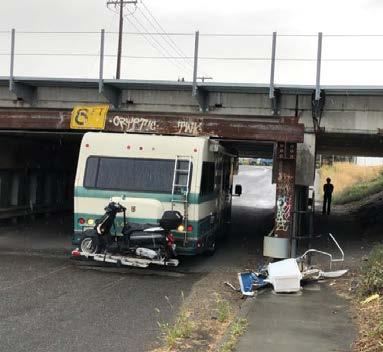
As I stood in the street crying, I was sure RV life was over for us. But luckily, Wade is pretty handy! We drove to Lowe’s, he patched us up, and we continued on to Canada. Several months later, a friend offered her garage and Wade, using the insurance money, fixed the roof and installed all new vents, fans, solar panels, and air conditioning. Since we did all the repairs ourselves, we even made some money on the deal.
We didn’t let this misadventure stop us from our dream of full-time RV life. We have now been traveling in our RV for more than four years. In fact, I am writing this from Baja California, Mexico, where our RV is parked on a cliff overlooking the ocean. Someone once told me, “It’s not if you will have an issue, it’s when.” Be prepared, be flexible, and know that at some point you, too, will have a misadventure to share. ■
 Melissa and Wade Nance @pennypinchingglobetrotter
Melissa and Wade Nance @pennypinchingglobetrotter
 By Madalyn Meyers
By Madalyn Meyers
When I tell people I’m a full-time RV traveler, their faces light up. Almost instantly, I can see the fantasy they’re picturing in their minds—the one where my husband, Drew, and I spend all day exploring national parks or lounging along striking southern beaches. It’s a romantic idea, really, and one that would be quite glamorous if it had any basis in reality. The sobering truth of RV life is that it is actually quite challenging, but in the best of ways. As dazzling as it may sound to be on an endless vacation, humans were meant to be challenged, to grow as people, to think deeply, and to gain knowledge, and while it may be surprising to hear, RVing is a fantastic lifestyle to enhance these skills.

I can confidently say I’ve learned far more during my days RVing than I ever did in a classroom. Being a full-time RVer has become the most enriching time of my life—I’m intellectually inspired and constantly picking up applicable real-world knowledge. Every day on the road is an opportunity to learn something new, and while RVing can often be unpredictable, there are also recurring themes that have led to the improvement of certain skills since we began traveling full time.


It’s never a question of if, but when, things will go wrong in an RV. It’s the great equalizer that unites all RVers. No matter what type of RV you own, how old it is, or what brand you have, the sheer quantity of moving parts ensures some of them will break from time to time.
This past winter, while experiencing freezing temperatures in Virginia, Drew and I were startled in the middle of the night by a sudden and persistent jackhammering noise. After the initial panic of fleeing the RV in fear it was about to explode, we embarked on a two-hour mission of determining the furnace was the source of the noise, figuring out a mouse was caught in the blower, and then deliberating over how to best survive the frigid temperatures until morning. In the end, we were able to spend a few nights with nearby family members while Drew and I researched, ordered, and then installed the part that the intruding mouse had broken. Each of these steps required effective problem solving under stressful circumstances.
Luckily, the more opportunities we have to exercise our critical thinking skills, the more capable we become at solving any dilemma that comes our way.

Much of what we consider our personal opinions is actually shaped by our environment. As impressionable beings, influences from our community and society play a large but subtle role in what we believe, and since people of similar mindsets tend to congregate together, we are prone to passively adopting the beliefs of our geographic area. It is challenging for us to recognize our own biases, and this is something I have only begun to acknowledge by frequently traveling to new places. Becoming an RVer has allowed me to live as an outsider for the first time in my life. I’ve interacted with all kinds of people from all over the country, from farmers and artists to professors and doctors. Each person I meet has different opinions and has overcome struggles I know nothing about. These experiences make it possible to see topics from new perspectives, to peel back our layers of bias, and to use our own innate intelligence to form independent thoughts and opinions.

If you ever want to put your communication skills with your partner to the test, try backing a camper into a tight campsite. Since Drew is our primary driver, I am often responsible for helping him squeeze our rig into precarious overnight parking spots while watching for trees, low hanging branches, rocks, changes in incline, and campground hookups. Since Drew can’t actually see much of the back end of our RV, I am his eyes and ears throughout this whole process.

Our first few tries at doing this, we naively assumed a few hand gestures communicated through our driver’s side mirror would suffice. We quickly realized how wrong we were and have since upgraded our methods to using long range walkie-talkies, which allow us to freely share information and avoid having to yell to make ourselves heard, which inevitably raises the tension level. The importance of effective communication also applies when I navigate us down unknown roads or explain my expectations for our travel days as he balances his work responsibilities.
I was a straight-A student throughout school, but that doesn’t help me when I attempt to remember anything I learned in fifth grade history. School is optimized to prepare students for exams, but the retention rate of information sharply declines past that point. It took me until I walked the Freedom Trail, passing by Paul Revere’s home and the site of the Boston Tea Party, that I began to realize the impact the city of Boston had in propelling the colonists into becoming active participants in the American Revolution.
As a full-time RVer, I have walked through the site of the pilgrims’ first landing, seen the graves of victims from the Salem witch trials, and explored every inch of the National Mall. By creating memories within spaces of historical importance, we are exceptionally more likely to remember the lessons we learn there. This is the science behind why schools take field trips. Our brains were meant to absorb information in the real world instead of behind a desk.
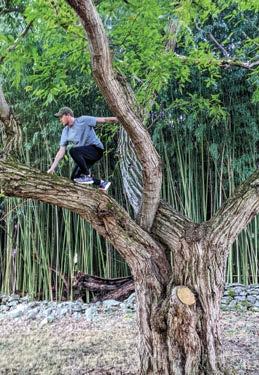

I once was told that comfort is the death of progress, and while I have always found this to be an interesting concept, I never grasped the gravity of its truth until I became a full-time RVer. The RVing lifestyle takes us out of our comfort zone, but it rewards us with intangible treasures of knowledge, self discovery, and personal growth. My motivation to explore my surroundings has skyrocketed with the understanding that my time in each destination is limited. This has been the stimulus that has gotten Drew and I to jump into a frigid Vermont waterfall, hike two hours in the dark to see the sun crest over the Green Mountains, and climb the trees along a hidden bamboo forest in Virginia’s State Arboretum. The time I used to spend in front of the television has been replaced by afternoons absorbing novel landscapes, exploring new museums, and tasting different cuisines. It is through these experiences that RVing becomes the platform that pushes us to be constantly challenged, constantly stimulated, and constantly learning, no matter our age. ■
About the Author
Madalyn Meyers is a resident of the road, traveling the United States in an RV with her husband, Drew, and dog, Charlie. She is an animal lover, yoga enthusiast, foodie, and avid hiker. Madalyn earned a master’s in ecology, and marries her passions for science, writing, and travel in her sciencethemed travel blog, Discovery Detour, which can be found at discoverydetour. com or followed on Instagram @discovery.detour.
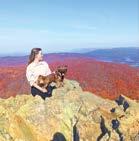
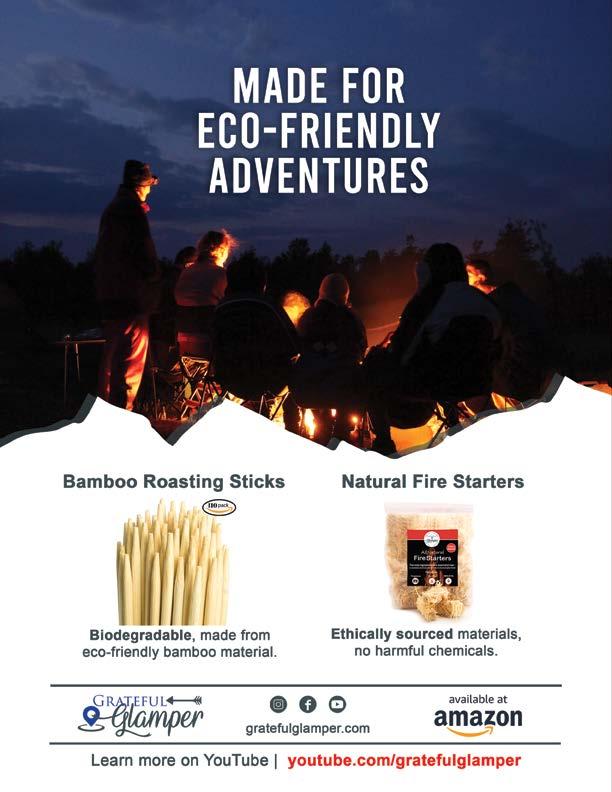
Being outside was never my thing. Everything needed to be just right before I could enjoy being out in the elements. A perfect 68–70 degrees, sunny but not too sunny, a cool breeze, but absolutely zero humidity. And for the love of all things, definitely no critters! That goes for bugs, reptiles, and rodents.
I used to meet rain, wind, cold, and heat with aggravation and impatience; these conditions were a matter of inconvenience. Nature and being out in the elements were simply transition places for me to get to my next destination. Getting to the next location or goal was my focus.
Well, divorce placed me in a transition place that scrambled my focus.
My next destination was unknown and the goal became: just don’t die. As a single mom, I learned I was stronger than I ever thought I was. From deep within me, there was a desire to stop being afraid of everything.
In an effort to make a change, I joined an online dating platform. I swiped right on a man named Jeff—a single dad with a nice smile. We had a few dinner and movie dates, but Jeff kept wanting to do outside stuff. He had a bike and asked me to go biking with him. I tried to get out of it by telling him I didn’t have a bike. His answer? “Oh, I bought you one.”

And that’s how this girl who never really went outside rode a bike for the first time in more than 25 years.
I also went skiing, golfing, zip-lining, biking down a mountain, and even hiking in the woods! I would be lying if I said I wasn’t afraid of some of these activities the first time, but I went for it, and I enjoyed it!
My new life of adventure was just beginning, and the guy with the nice smile became my husband. Just before our first anniversary, Jeff suggested we go camping. I immediately rejected the idea, because being outside for a few hours doing an activity was one thing, but sleeping outside was a whole different story. When Jeff presented the idea of an RV, he got my attention. Having our own RV would mean running water, heat, air conditioning, and an inside bathroom. Was I still trying to control nature? Yes, absolutely.
We purchased our first travel trailer without ever going camping. On our first trip, getting the camper level took more than an hour and we locked the keys inside. But I truly experienced nature for the first time. I got overwhelmed watching some ducks paddle in the lake. How had I missed all this glory for this long?
After that first trip, I was bitten by the camping bug. I mixed my new love for nature and my love of home decor. Part of the fun of camping for me is decorating the RV. Jeff shakes his head when I bring seasonal decor on our trips, but I know he secretly enjoys the coziness!
Jeff and I are weekend campers and we do the majority of our camping close to home. Since I’m late to the outdoor party, there is so much nature for me to experience in my own backyard! Our routine is to stay at various campgrounds and take in some of the local food and attractions. Dives, diners, wineries, state parks, and unique biking trails are some of our favorite things to experience while camping.
People often ask us how far away we’ve traveled in our RV, and when we answer “five hours,” they scoff. Secretly, I want to say, “Homie, we haven’t done a third of the stuff ten minutes away; we will get there!” Taking our RV to the Grand Canyon is definitely on our bucket list.
I think one of the reasons I love camping so much is because it’s something Jeff and I started together. In a second marriage, especially when children are involved, many traditions and patterns are already in place, and each partner must graciously maneuver around them. We introduced our blended family to camping. Even though our kids are all young adults navigating their own lives, we have made some new memories with them!
I used to say camping was about problem solving because something always goes wrong. But really, camping is about gaining perspective on life. When we camp, moments are taken one by one, including any imperfections like rain, mechanical malfunctions, and traffic.
Moments with our family and in our marriage are far from perfect, but they are ours. We can choose to accept them, as fragmented as they may be, or reject them because everything is not perfect. Weather is no longer a distraction for me. I still don’t love the critters, but I’m getting better day by day.
Jeff and I usually camp at least once a month, all year long! We even tent camped without a real bathroom a few months ago and had a blast.
We are on a mission to inspire other “inside peeps” to step outside. I am so thankful Jeff encouraged me to start RVing and exploring God’s landscape. We truly “love by camping.” ■


About the Author
Katina Boyd is a clinical pharmacist, home decor stylist, mom, and one half of Love By Camping. She and her husband, Jeff, explore local sites close to their home in their RV and record their adventures on their YouTube channel, Love By Camping. They are on a mission to inspire other people to get outside. Jeff and Katina have three children: Braxton, Aryonna, and Anaiya. Follow their adventure on Instagram @lovebycamping.




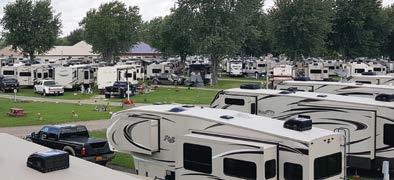
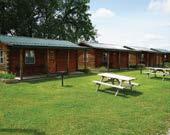

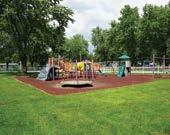





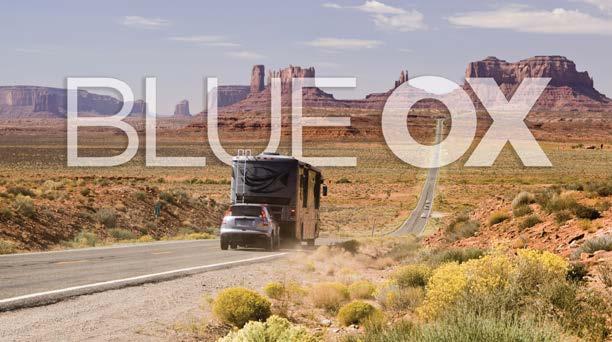
 By Christina Stawiasz
By Christina Stawiasz
As a self-taught home chef, I have combined my passion for cooking and my love of nature with our camper. Great meals aren’t just created in sticks and bricks homes and restaurants. You can absolutely enjoy delicious, impressive, gourmet food at your campsite or on the road. We recently upgraded from a teardrop camper to a 21-foot RV and we haven’t looked back!
The convenience of my tiny kitchen and storage allows for endless possibilities. I always pack a travel grill, a good old cast iron, and an abundance of herbs and spices. My refrigerator allows me to create fresh, healthy meals, and I enjoy stocking up on fresh produce at local farmers markets in the area. Having an RV has made traveling so much easier and more convenient that we have been able to venture out farther and longer. I thoroughly
enjoy shopping and supporting local markets, which means I have been able to explore an abundance of new foods. Talk about a game changer for someone who loves cooking.
In my previous camping life, I was a diehard tenter. My husband, Bram, and I would pack our little green two-door Jeep Wrangler to the brim, with literally zero room to spare. We’d drive off toward the forest, stopping at a nearby grocery store to dig out the cooler. We never seemed to pack lightly, even when the campsite was only a half-mile hike from the Jeep, so we would end up making four or five trips back and forth with a heavy cooler and bin full of canned goods just so I could get creative with some camp dinners.
One day Bram said he was interested in looking at RVs. “Are you serious? That’s camp cheating!” was my initial reaction. To appease this silly notion, I agreed to at least window shop. It certainly didn’t take too long to change my mind—after all, they do have kitchens. We agreed that if we decided to get one, it must be small. Because we spent years camping in a tent, for some reason I rationalized that a teardrop RV would feel less
like tent cheating. My mind was flooded with so many ideas of what I would be able to create for meals on our exciting adventures. This also meant no more melted ice and trying to keep everything cold for days on end during a hot summer season. I was ready to create some exceptional meals in the great outdoors.
It didn’t take very long to adapt and love the idea of RVing. In fact, that teardrop trailer that once felt so roomy soon wasn’t enough. We wanted more storage, more space, a bigger bathroom, then a wet bath … and an actual bed!
According to our salesperson, this is a common occurrence with new RV owners.
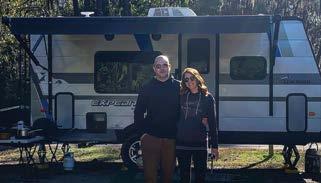
Who have I become? Where was that rough and tough, dirty, die-hard tenter who would dig through a cooler full of melted ice bobbing for waterlogged produce? As much as I loved that life, switching to an RV didn’t mean it ended. A whole new world of possibilities had become accessible, and I can now say that I am a very proud RV owner.
Don’t be intimidated by the smaller kitchen; think of it as an opportunity to create the home-cooked meals you love. Become comfortable cooking
1 (1-1 ½ pound) pork tenderloin
1 ½ tablespoons fennel seeds, roughly chopped
3–4 garlic cloves, minced
2 tablespoons finely chopped fresh rosemary, about 4–5 sprigs
1 tablespoon olive oil
1 tablespoon coarse ground mustard
½ teaspoon black pepper
¼ teaspoon salt
8–10 slices of prosciutto, about 6 oz
● Preheat the grill to medium heat.
● Pat the pork tenderloin dry with a paper towel.
● Trim any excess fat and silver skin.
● Combine fennel seeds, garlic, rosemary, olive oil, coarse ground mustard, salt, and pepper. Rub mixture on the tenderloin. (If you have time, allow to marinate overnight.)
● Next, wrap in prosciutto, carefully secure closed with butcher twine, and lightly rub with olive oil.
● Oil grill grates and sear pork tenderloin on all sides to crisp the prosciutto, turning about every 5–6 minutes. Cook until the internal temperature reaches 145 degrees, about 25 minutes. For well done, continue cooking until the temperature reaches 160 degrees. Remove from the grill and allow to rest for 10 minutes before carving. Note: If your grill runs hot, transfer tenderloin to indirect heat after searing on all sides to prevent burning.
outside by using your campfire or taking along a travel grill. You can cook, roast, and bake just about anything on the grill—believe me, it’s been done! Think outside the box of normal camping food, like hamburgers and hot dogs.
For example, prosciuttowrapped pork tenderloin with rosemary and fennel seeds has become a go-to and is an all-time family favorite. Not only is it incredibly simple to throw together, it’s also not at all boring Plus, it cooks quickly and pairs perfectly with any of your favorite sides. Who doesn’t like an easy meal, especially when it’s also delicious? It doesn’t get any better than enjoying your travels comfortably in your RV and ending the evening with a meal to remember. ■
About the Author Christina Stawiasz is the creator of Thyme + Timber. She currently travels with her husband Bramdon in their 21-foot Coachmen Expedition. Thriving in nature and catching all the local markets along the way to create meals for thymeandtimberlife. com, you can also find her on Instagram @thyme.and.timber.

Don’t be intimidated by the smaller kitchen—think of it as an opportunity to create the home-cooked meals you love.
Become comfortable cooking outside by using your campfire or taking along a travel grill. You can cook, roast, and bake just about anything on the grill —it’s been done!

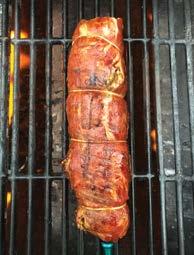






What is an RV product that you love? We posed this question to our contributors and the responses may surprise you!
Knowing the companies and products that other RVers rely on when they are on the road, can help to make your next adventure more comfortable and cozy.

Enjoy cooking in the great outdoors with the Gas One portable stove. It’s perfect for picnic tables or anywhere else you’d like to cook when you’re out and about. The cooktop is fueled by a butane canister that is easily installed in a matter of seconds. It’s also removable for storage and traveling.
The Gas One burner comes in a carrying case to help you stay organized, and the automatic ignition gets the flame going in no time at all. You can take it on all your adventures, and it’s also great to have around the house for emergency use.
A favorite among avid outdoor enthusiasts because each wipe is basically a shower on the go! That means you can venture anywhere, even places without water and showers, and still stay fresh and clean.

The wipes are unscented, so there’s no heavy perfume smell covering things up. They’re made with aloe, vitamin E, and tea tree oil, and one side is textured to help get the grime off.
Gone are the days of using baby wipes to freshen up in some of the most beautiful and remote places. These massive wipes are 350% bigger than a baby wipe and genuinely get the job done. Dispose of it when you’re done— they’re biodegradable—or rinse and reuse to clean off your gear.
And if your pup adventures with you, you’ll be glad to know Venture Wipes are pet-friendly too.
“We love that this tote allows us to boondock longer.”
–The Barthels @stresslesscamping
The Thetford Titan 21-gallon 4-wheel tote is great for those who love to boondock for extended periods, but whose tanks don’t allow for it. Having the extra tank can allow you more days at one site.
The unit arrives completely assembled with the exception of the elbow that connects the hose to the sewer outlet, and contains a large ball valve with an easy-turn handle. When the tank is full, just remove the hose from the camper, add the ball valve, and take the tank to a dump station.
To avoid overfilling, an air valve seals when the water level gets close to the top. Another door opens to reveal a hole for flushing out the tank.
The wheels are fairly large and roll easily on gravel. The handle folds underneath the tank for storage, and flips up to attach to the ball of the tow vehicle for short-distance towing.


A lot of basic meals can be made while camping just by boiling water. So why waste precious time in nature watching that water boil? Jet Boil boils water in a flash—100 seconds, to be exact. It’s perfect for rehydrating camping meals or making your morning coffee. It’s compact and portable, so it can be packed up for longer backpacking or hiking trips too.
There is no guessing when your water is hot and ready because of the color-changing flame on the side. When it’s all yellow, it’s ready to go.

Stay warm and cozy even in the coldest temperatures with the Mr. Heater Portable Propane Buddy Heater. Attach a 1-pound propane cylinder to keep it running for several hours, or use a hose adapter and 20-pound propane tank for longer use. Safety features include the metal grate on the front, foldable handle, and tip-over shutoff.
You can use the Buddy Heater to stay warm for a while, run it briefly to take the chill off, or sit in front of it outside to stay comfortable in the elements. If there are any tent campers in your family, they’ll be grateful for this too—it’s perfect for tent use.
Have a product you love?
Tell us about it! Email: collab@rvtoday.com and your product review may be featured in an upcoming issue of RV Today.
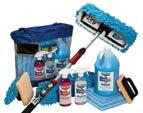
The RV lifestyle is not without its challenges. For many full-time RVers, keeping the RV clean is one that ranks right up at the top.
Many RV parks and campgrounds prohibit the use of water to wash RVs. This presents an issue for RVers who like to keep things neat and tidy.
“Using Wash Wax ALL on our RV completely changed how we feel about the dreaded task of keeping our RV clean,” –Brian and Shawnna Johnson @lyf_uninterrupted
Now you can wash your RV anywhere with no restrictions. The Johnsons agree that perhaps the best benefit of the Wash Wax Mop is that you can clean your RV in half the time without climbing a ladder!
If your rig lacks an oven, this portable option will allow you to make many homecooked oven meals on the road.
Ari and Jessi use their Omnia oven while camping to make dishes including cinnamon rolls, cornbread, and tortellini pasta. Their 2008 Roadtrek 190 Popular 4x4, gives them plenty of

If you have concerns about using propane, you’re not the only one. That’s why you’ll be glad to know there is a product that can help you use propane more safely. GasStop can help put your mind at ease with its attachable shut-off valve, which activates in the case of a major leak.
The adapter can also help monitor propane levels in your tank and let you know when it’s running low. It is available in both POL and ACME connection types. It’s easy to install, easy to use, and comes with a 5-year warranty.
GasStop can help you enjoy family camping trips more with one less thing to worry about.
cooking options already (a gas stove, camping stove, microwave, and InstantPot). But for the times when they just need an oven, the versatility and quality of their Omnia comes in handy.

As an added bonus, the Omnia travels well due to its carrying bag and small overall footprint. It’s compact enough that they can store it inside their small microwave—a big deal when you’re living in a Class B RV.

12 Volt LiFePO4 Battery
If you’re ready to trade your lead acids in for something more substantial to power your off-grid adventures, “We recently installed two 300ah batteries from Enduro Power and they are LEGIT!”
–Joe @letsheadwherever Their previous two lead acid batteries would struggle to keep up for a single day of off-grid camping. Now with 600 amp hours of lithium battery power, they can stay off-grid for days.
Update this and no bold quote: What Joe loves most about Enduro Power batteries is that they offer numerous capacities for affordable prices. Being able to install 300ah batteries instead of multiple 100ah batteries is a massive space saver, especially considering the smaller case that Enduro Power uses compared to other battery brands.

Now they’re looking forward to being juiced up and ready for some amazing off-grid camping adventures throughout 2022 and beyond!
“Our toy hauler is our baby, and we love to travel this amazing country hauling our motorcycle to ride in beautiful places.”
–Joe Gross, Lippert Scout
While his 2018 Forest River Vengeance 394V13 fifth wheel already traveled well, frequent bumps and potholes on the road led him to research and settle on the Lippert Center Point to improve suspension.
“I figured if it was good enough for most all the semi trucks on the road, it would be good for us,” Joe said. He touts ease of installation (he was able to complete the install himself), fit and finish of the parts, and accuracy of the install sheets.
Now for road test time! He drove more than 60 miles with a glass of water in the sink, and he lost less than 1/8th of an inch of water from the cup. ■
I was amazed looking in the mirrors at how little the camper moved around.
The ride quality was stellar.
–Joe Gross, Lippert Scout
“Most van-type RVs don’t have room for a built-in oven, but with an Omnia oven, anyone can put baking back into their meal planning.”
– Ari and Jessi Adler @trekersorg
Stay connected with fellow RVers at these 2022 events
MARCH
Fred Hall Show Long Beach
March 2–6
Long Beach, CA
33rd Annual Springfield RV Mega Show
March 11–13
Springfield, MO
Trailerfest Vintage Trailer Rally
March 31–April 3
San Dimas, CA
APRIL
18th Annual Vacationland RV & Camping Show
April 2–3
Auburn, ME
Arkansas State RV Rally
April 14–17
Texarkana, AR
Escapees RVers Boot Camp
April 15–17
Dillard, GA
Republic of Nomads Alliance Event
April 17-24
Logandale, NV
MAY
Northeast Adventurers RV Rally

May 1–5
New Holland, PA
Grand Design Owners Kanab Utah Rally
May 12–16
Kanab , UT
RVing Women Meetup
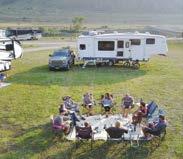
May 19–22
Sarasota, FL
JUNE
Ontario Grand Design Owners Rally
June 3–5
Prince Edward, ON
50th Anniversary Tiffin Allegro Club Rally
June 13–18
Rock Springs, WY
FROG Brass Ring Rally
June 16–19
Catawissa, PA
JULY
Open Roads Van Life Festival
July 15–18
McCall, ID
Redwood RV Owners Group Rally
July 16–24
Shipshewana, IN
FMCA Eastern Area Rally
July 13–16
Lewisburg, WV
AUGUST
Rootless Living Magazine Digital Nomad Meetup
August 5–7
Elkhart, IN
Vintage Camper Trailers Boot Camp
August 11–14
Hollister, CA
FMCA’s 105th International Convention
August 24–27
Lincoln, NE
Events listed are a courtesy to our readers, with dates and details subject to change. For more information, contact the event organizers directly. If you want your next event listed here, please email info@RVToday.com.
Stacy Maxon
Gerri Almand
Anne Klumpp
Julie Chickery
Adam & Kathryn Frazer
Nate Axness
Nicoll Davis
Melissa & Wade Nance

Kevin Arnold
Dani Dukes
Blake Scott
Rachel Firmin
Madalyn Meyers
Jeff & Katina Boyd
Christina Stawiasz
Nicole Dela Cruz
Christina Pate
Ari Adler
Danielle Isermann
Lauren Lynass
Patty Gill
Melissa Nance
Anette Garcia
Kathryn and Adam Frazer Adam, Kathryn, and Kona are an adventurous married couple and their pup living on the road in their selfconverted sprinter van. You can often find them driving all around the U.S. and Canada scoping out the best coffee shops, eating tacos and ice cream (they’re a fiveplus taco and two-plus scoop household), and enjoying nature. To see more of their travels and detailed travel guides, check out their website adventuresofaplusk. com, subscribe to their YouTube channel Adventures of A+K, or follow them on Instagram @AdventuresofAplusK

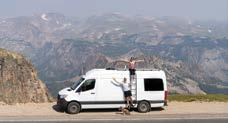
The 1910 Pierce-Arrow Touring Landau is considered by many to be the first RV.
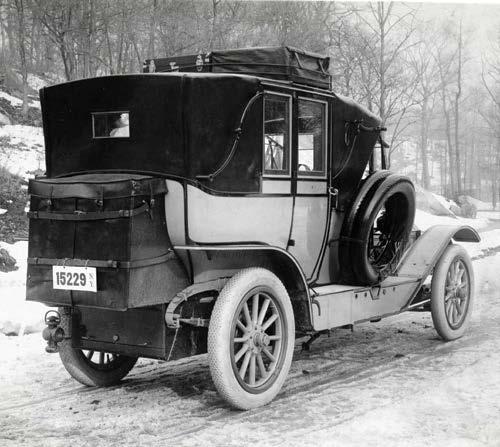 Photo Credit: RV/MH Hall of Fame and Museum
Photo Credit: RV/MH Hall of Fame and Museum

THE ONLY 100% AUTOMATIC SHUT-OFF SAFETY DEVICE FOR YOUR PROPANE SYSTEM.
